

The Moon Ephemeris Calculator
Compute the position of The Moon for any date and time between 1 January 1600 and 30 December 2499 and display the results on an interactive star map.
In Evidence
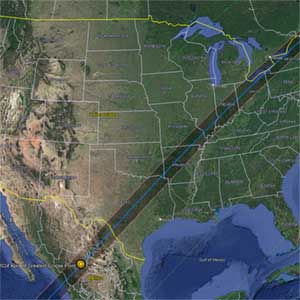
The Moon is Earth's only natural satellite and is the fifth-largest satellite in the solar system. It has a diameter of 3,474 kilometers and a mass of 7.34 x 10^22 kilograms, making it about 1/81st the mass of Earth. The Moon's surface is covered in craters, mountains, and plains, with the largest feature being the Imbrium Basin. The Moon has no atmosphere and no magnetic field, which means that it is exposed to the solar wind and cosmic rays. It has a day length of 29.5 Earth days, which is also the length of its orbital period around Earth. The Moon has been used as a celestial body for human exploration and scientific study. The first human landing on the Moon was in 1969 during NASA's Apollo 11 mission, and since then, several missions have been sent to study the Moon's geology, surface features, and potential for future human exploration and colonization.
The Moon tonight is in Waning Gibbous phase and is currently in the constellation of Libra , at a distance of 396,286 kilometers from Earth.
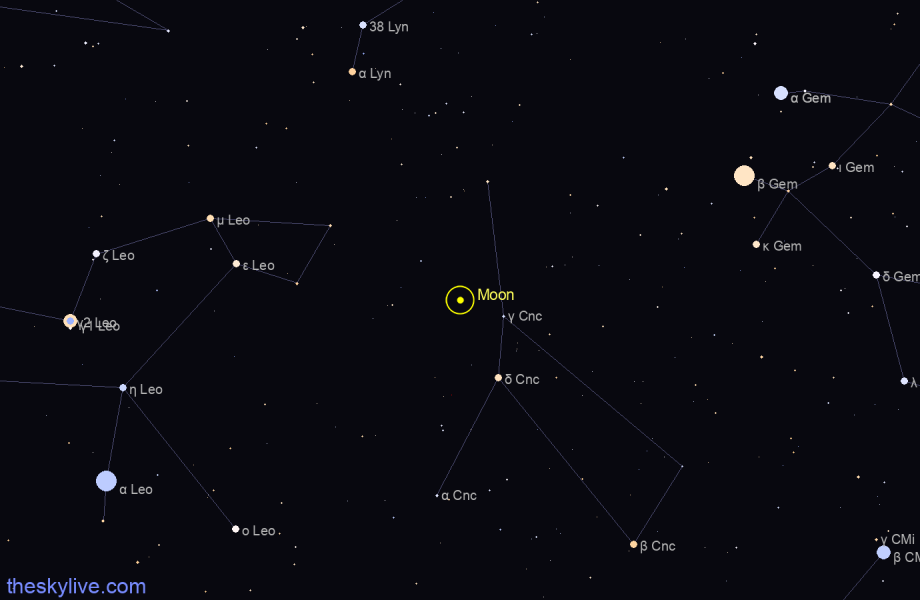
Today's rise, transit and set times of The Moon from Greenwich, United Kingdom edit_location_alt (all times relative to the local timezone Europe/London):
- Moon is below the horizon from Greenwich, United Kingdom edit_location_alt .
- Go to interactive sky chart
If you need to access this information frequently for your observations, you can create a simple customized Quick Access page , so that you can easily bookmark it in your browser favorites or add a shortcut to your mobile phones' home screen.
- Current Phase of the Moon
- Moon Calendar : track the phases of the moon for each day
- Position and finder charts (see also Where is The Moon? )
- Distance from Earth (see also How far is The Moon from Earth? )
- When does The Moon rise and set?
- Brightness (see also How bright is The Moon? )
- Physical data . Detailed information about physical properties of The Moon, such as mass and geometric properties.
- 15 days ephemerides . Table showing celestial coordinates and magnitude of The Moon for the past and next 7 days.
- Interactive sky chart . An online planetarium application that shows where to locate The Moon in the sky from your location.
The Moon Position and Finder Charts
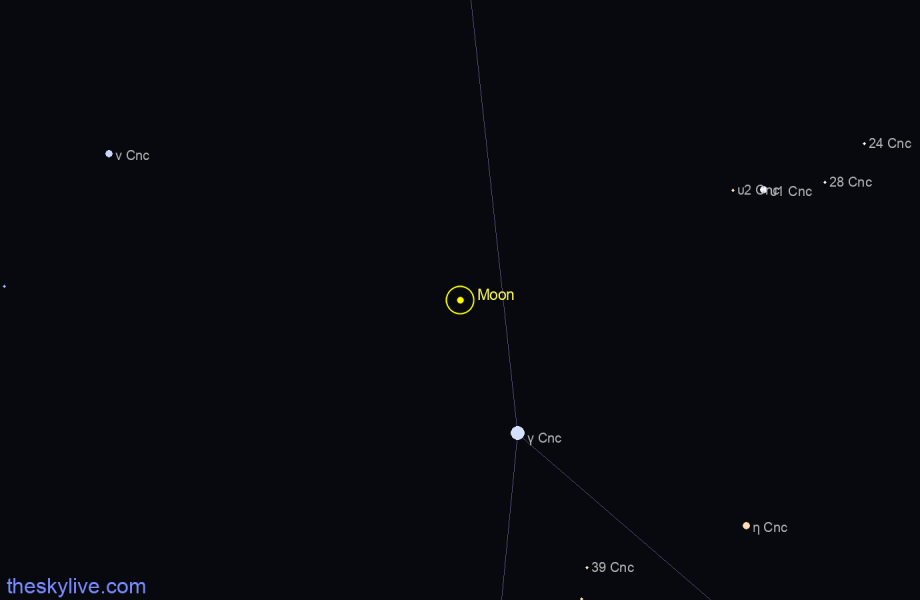
Also check out Where is The Moon? , a page that provides all the information needed to find The Moon in the sky and additional links to sky charts.
The Moon Distance from Earth
The distance of The Moon from Earth is currently 396,286 kilometers, equivalent to 0.002649 Astronomical Units . Light takes 1.3219 seconds to travel from The Moon and arrive to us.
The following chart shows the distance of The Moon from Earth as a function of time. In the chart the distance data is measured in Astronomical Units and sampled with an interval of 1 day.
Closest Approach of The Moon to Earth
NOTE: values for the closest approach are computed with a sampling interval of 1 day.
The Moon Brightness and Light Curve
The following chart is the predicted light curve (visual magnitude as a function of time) of The Moon, according to the most recent ephemerides data. Magnitude data is sampled with a 2 days interval and there might be inaccuracies for objects changing brightness very rapidly during the course of a few days. For comets there could be large discrepancies between the observed and predicted brightness because of their highly dynamic behaviour.
The Moon Physical Data
The following shows the known values of the most important physical parameters of The Moon. Source: JPL Small-Body Database
The Moon 15 Days Ephemeris
The following table lists the ephemerides of The Moon computed for the past and next 7 days, with a 24 hours interval. Click on each row of the table to locate The Moon in our Online Planetarium at the chosen date.
NASA (National Aeronautics and Space Administration)
- Solar Eclipses
- Lunar Eclipses
- Planetary Transits
- 12-Year Ephemeris
- Moon Phases
Eclipse Web Site
By fred espenak, gsfc planetary systems laboratory, eclipses and the moon's orbit, fred espenak, nasa's gsfc, 4.1 introduction.
The Moon revolves around Earth in an elliptical orbit with a mean eccentricity of 0.0549. Thus, the Moon's center-to-center distance from Earth varies with mean values of 363,396 km at perigee to 405,504 km at apogee. The lunar orbital period with respect to the stars (sidereal month) is 27.32166 days (27d 07h 43m 12s). However, there are three other orbital periods or months that are crucial to the understanding and prediction of eclipses. These three cycles and the harmonics between them determine when, where, and how solar and lunar eclipses occur.
The mutual gravitational force between the Sun and Moon is over twice as large as between the Moon and Earth. For this reason, the Sun plays a dominant role in perturbing the Moon's motion. The ever changing distances and relative positions between the Sun, Moon, and Earth, the inclination of the Moon's orbit, the oblateness of Earth, and (to a lesser extent) the gravitational attraction of the other planets all act to throw the Moon's orbital parameters into a constant state of change. Although the Moon's position and velocity can be described by the classic Keplerian orbital elements, such osculating elements are only valid for a single instant in time (Chapront-Touze' and Chapront, 1991). Nevertheless, these instantaneous parameters are of value in understanding the Moon's complex motions particularly with respect to the three major orbital cycles that govern eclipses.
4.2 Synodic Month
The most familiar lunar cycle is the synodic month because it governs the well-known cycle of the Moon's phases. The Moon has no light of its own but shines by reflected sunlight. As a consequence, the geometry of its orbital position relative to the Sun and Earth determines the Moon's apparent phase.
The mean length of the synodic month is 29.53059 days (29d 12h 44m 03s). This is nearly 2.21 days longer than the sidereal month. As the Moon revolves around Earth, both objects also progress in orbit around the Sun. After completing one revolution with respect to the stars, the Moon must continue a little farther along its orbit to catch up to the same position it started from relative to the Sun and Earth. This explains why the mean synodic month is longer than the sidereal month.
According to astronomical convention, New Moon is defined as the instant when the geocentric ecliptic longitudes of the Sun and Moon are equal. When the synodic month is measured from New Moon to New Moon, it is sometimes referred to as a lunation, and we will follow that usage here. Historically, the phases of the Moon have been used as the basis of lunar calendars by many cultures around the world. The major problem with such calendars is that the year, based on the solar calendar, is not evenly divisible by a whole number of lunations. Consequently, most lunar calendars are actually lunisolar calendars (e.g., Chinese, Hebrew, and Hindu) that include intercalary months to keep the seasons in step with the year.
The duration of the lunation actually varies from its mean value by up to seven hours. For instance, Table 4-1 contains details for all lunations in 2008. The first column lists the decimal date of every New Moon throughout the year (Terrestrial Dynamical Time), while the second column gives the duration of each lunation. The third column is the difference between the actual and mean lunation. The first lunation of the year (Jan 08) was 03h 23m longer than the mean. Continuing through 2008, the length of each lunation drops and reaches a minimum of 05h 48m shorter than the mean value (Jun 03). The duration now increases with each succeeding lunation until the maximum value of the year is reached of 06h 49m longer than the mean (Dec 27).
What is the cause of this odd behavior? The last column in Table 4-1 gives a clue; it contains the Moon's true anomaly at the instant of New Moon. The true anomaly is the angle between the Moon's position and the point of perigee along its orbit. In other words, it is the orbital longitude of the Moon with respect to perigee. Table 4-1 shows that when New Moon occurs near perigee (true anomaly = 0°), the length of the lunation is at a minimum (e.g., Jun 03). Similarly, when New Moon occurs near apogee (true anomaly = 180°), the length of the lunation reaches a maximum (e.g., Dec 27).

This relationship is quite apparent when viewed graphically. Figure 4-1 plots the difference from mean lunation (histogram) and the Moon's true anomaly (diagonal curves) for every New Moon from 2008 through 2010. The left-hand scale is for the difference from mean lunation, while the right-hand scale is for the true anomaly. The shortest lunations are clearly correlated with New Moon at perigee, while the longest lunations occur at apogee. From the figure, the length of this cycle appears to be about 412 days. The reason why must wait until the next section.
The Moon's orbital period with respect to perigee is the anomalistic month and has a duration of approximately 27.55 days. The lock-step rhythm between the lunation length and true anomaly can be explained with the help of the anomalistic month and Figure 4-2. It illustrates the Moon's orbit around Earth and Earth's orbit around the Sun. The relative sizes and distances of the Sun, Moon, and Earth as well as the eccentricity of the Moon's orbit are all exaggerated for clarity. The major axis of the Moon's orbit marks the positions of perigee and apogee.

Two distinct cases-each consisting of two revolutions of the Moon around Earth-are depicted in Figure 4-2. The first case covers the New Moon geometry around perigee. The orbit marked A shows New Moon taking place near perigee at position a1. One anomalistic month later (orbit B), the Moon has returned to the same position relative to perigee (marked b1). However, Earth has traveled about 30° around its orbit so the Sun's direction relative to the Moon's major axis has shifted. The Moon must travel an additional distance of Δb in its orbit before reaching the New Moon phase at b2. This graphically demonstrates why the synodic month is longer (~1.98 days) than the anomalistic month.
The second case takes place about half a year later. New Moon then occurs near apogee (orbit C, position c1). After one anomalistic month, the Moon has returned to the same location with respect to apogee (orbit D, position d1). Once again, Earth has traveled about 30° around its orbit so the Moon must revolve an additional distance of Δd before reaching the New Moon phase at position d2.
An inspection of orbits B and D reveals that the orbital arc Δd is longer that Δb. This means that the Moon must cover a greater orbital distance to reach New Moon near apogee as compared to perigee. Furthermore, the Moon's orbital velocity is slower at apogee so it takes longer to travel a given distance. Thus, the length of the lunation is shorter than average when New Moon occurs near perigee and longer than average when New Moon occurs near apogee. Earth's elliptical orbit around the Sun also factors into the length of the lunation. With an eccentricity of 0.0167, Earth's orbit is about one third as elliptical as the Moon's orbit. Nevertheless, it affects the length of the lunation by producing shorter lunations near aphelion and longer lunations near perihelion.
During the 5000-year period covered in this catalog, there are 61841 complete lunations. The shortest lunation began on -1602 Jun 03 and lasted 29.26574 days (29d 06h 22m 40s; 6h 21m 23s shorter than the mean). The longest lunation began on -1868 Nov 27 and lasted 29.84089 days (29d 20h 10m 53s; 7h 26m 50s longer than the mean). Thus, the duration of the lunation varies over a range of 13h 48m 13s during this time interval.
The histogram presented in Figure 4-3 shows the distribution in the length of the lunation over 5000 years. To create the histogram, the durations of individual lunations were binned into 30-minute groups. It might seem reasonable to expect a simple bell-shaped Gaussian curve. However, the results are surprising because the distribution in lunation length has two distinct peaks. This bifurcation can be understood if the lunation length, which depends primarily on the Moon's distance, is considered as a series of sine functions. The extremes of a sine function always occur more frequently than the mean, which is just what is seen in Figure 4-3. For a more detailed discussion, see Meeus (1997).

4.3 Anomalistic Month
The anomalistic month is defined as the revolution of the Moon around its elliptical orbit as measured from perigee to perigee. The length of this period can vary by several days from its mean value of 27.55455 days (27d 13h 18m 33s). Figure 4-4 plots the difference of the anomalistic month from the mean value for the 3-year interval 2008 through 2010. Also plotted is the difference between the mean longitudes of the Sun and perigee. This is just the angle between the Sun and the Moon's major axis in the direction of perigee. The left-hand scale is the length of the anomalistic month minus the mean value, while the right-hand scale is for the difference in longitude (Sun-perigee). For comparison, the lunation length minus its mean value is also plotted (light gray).

The variation in the length of the anomalistic month is much larger than that of the lunation. Figure 4-4 shows the anomalistic month is typically within 1 day of its mean value. But once or twice every 7 to 8 months, the anomalistic month is significantly shorter than the mean by 2 to nearly 3 days. The difference in longitude of the Sun and perigee show that the shortest anomalistic months are correlated with values of 90° and 270°, when the line of apsides is perpendicular to the Sun's direction.
In comparison, the longest anomalistic months take place when the difference in longitude passes through 0° or 180°. The line of apsides is then directed towards or away from the Sun. The maximum duration of the anomalistic month is then about 28.5 days (1.0 day longer than the mean). The Earth-Sun distance also influences the anomalistic month by causing greater extremes near perihelion. This currently occurs in early January each year.
In an earlier discussion on the synodic month, it was assumed that the lunar orbit's line of apsides has a fixed and permanent direction in space. In fact, the length of the mean anomalistic month (27.55 days) exceeds the mean sidereal month (27.32 days) by 0.23 days. Thus, the Moon's major axis slowly shifts with a mean rate of 0.11140° per day in the direct sense, that is, in the same direction as the Moon's orbital motion. This corresponds to an average of 40.7° per year, so it takes 8.85 years (3231.6 days) for the line of apsides to make one complete revolution with respect to the stars.
What impact do the varying length of the anomalistic month and the direct (eastward) rotation of the Moon's elliptical orbit have on the length of the lunation? To answer this, one must first consider Earth's elliptical orbit around the Sun, which has a mean eccentricity of 0.0167. The center-to-center distance between Earth and the Sun varies with mean values of 147,098,074 km at perihelion to 152,097,701 km at aphelion. The direction of Earth's orbital line of apsides also changes but at a rate far slower than the Moon's. Having a direct (eastward) shift with a mean value of 0.0172° per year, it takes about 20,500 years for Earth's major axis to make one complete revolution. This is only 0.0004 of the lunar rate, so it can be treated as fixed for the purpose of the following discussion.
At certain times, the perigee of the lunar orbit and the perihelion of Earth's orbit can have the same ecliptic longitude. Ignoring the 5.1° tilt of the Moon's obit, the major axes are then essentially parallel to each other and point in the same direction. As time passes, the major axis of the lunar orbit slowly rotates east with respect to Earth's major axis until it becomes perpendicular to it 2.21 years later. In another 2.21 years (4.42 years from the start), the major axes of the orbits are again parallel to each other, but the perigee and the perihelion are 180° apart as they point in opposite directions. After an additional period of 2.21 years, the axes are once more perpendicular. Finally, the Moon's perigee and Earth's perihelion again share the same ecliptic longitude after a total interval of 8.85 years.
The length of each lunation minus the mean lunation is plotted in Figure 4-5 for the 20-year period from 2008 through 2027. The periodic rhythm between the lunation length and the true anomaly, as described earlier (via Figure 4-1), can now be seen over the course of two decades. The 412-day mean period of this cycle corresponds to the time between two consecutive alignments of the major axis in the direction of the Sun. It is slightly longer than a year because of the slow eastward shift of the Moon's major axis.

An interesting feature revealed in Figure 4-5 is how the extremes in the lunation length slowly vary over a period of nearly 9 years. The envelope defined by the minima and maxima appears to oscillate over a range of values from �2 h to �6 h. This behavior is evidence revealing the influence of the 8.85-year cycle in the alignment of the major axes of the orbits of the Moon and Earth.
The amplitude of the envelope is due to the eccentricity of Earth's orbit. When Earth is at perihelion, its orbital velocity is at its maximum value so Earth travels a larger distance around its orbit in a given time as compared to aphelion. Thus, the Moon must travel a greater distance to align with the Sun, which results in a longer lunation. Near aphelion, the opposite conditions produce a shorter lunation.
Using the axis scale on the right, the diagonal lines in Figure 4-5 plot the angle between the Moon's perigee and Earth's perihelion. This is the difference between the Moon's mean longitude of perigee and Earth's true longitude of perihelion. When the angle between the perigee and perihelion is 0°, the length of the lunation varies from a minimum of 29.273 days (-6.17 hours from mean) to a maximum of 29.820 days (+6.93 hours from mean). Similarly, when the angle between the perigee and perihelion is 180°, the length of the lunation varies from a minimum of 29.452 days (-1.88 hours from mean) to a maximum of 29.628 days (+2.33 hours from mean). To summarize, the greatest extremes in the length of the lunation occur when the longitudes of the Moon's perigee and Earth's perihelion are equal. The smallest extremes in the lunation length occur when their longitudes differ by 180°.
Although the Moon's major axis rotates eastward at a mean rate of 0.1114° per day, the true rate varies considerably. Figure 4-5 illustrates the variation by plotting the difference between the true longitudes of the Moon's perigee and Earth's perihelion. This quasi-sinusoidal oscillation about the difference in the mean longitudes shows peak departures of �30° from average. Indeed, the Moon's major axis can swing both east and west of its mean value, taking on an actual retrograde shift west during some anomalistic months.
This dynamic behavior is due to the gravitational pull of the Sun on the Moon as it orbits Earth. Consequently, a continuous torque is applied to the lunar orbit in an unsuccessful effort to permanently align the major axis towards the Sun. The annual orbit of the Earth-Moon system around the Sun coupled with the Moon's synodic orbit around Earth mean that the conditions for such a permanent alignment are always changing. The overall effect is to twist and distort the shape and orientation of the Moon's elliptical orbit.
It was stated earlier that the Moon's mean orbital eccentricity is 0.0549, but this too is subject to large changes because of solar perturbations. Figure 4-6 plots the variation in the Moon's orbital eccentricity from 2008 through 2010. The instantaneous eccentricity (light gray curve) oscillates with a period tied to the synodic month and ranges from 0.0266 to 0.0762 over this 3-year interval. Superimposed on the instantaneous eccentricity is the eccentricity at the instant of perigee, which occurs at the beginning of each anomalistic month (heavy black curve). The straight diagonal lines represent the difference between the mean longitudes of the Sun and perigee. In other words, it is the angle between the Moon's perigee-directed major axis and the Sun. Oscillating about this line is the difference between the true longitudes of Sun and perigee. The scale for these angles appears along the right side of Figure 4-6. The extreme range of the Moon's orbital eccentricity at perigee during the 5000 years covered by the catalog is 0.0255 to 0.0775.

Figure 4-6 shows that the eccentricity reaches a maximum when the major axis of the lunar orbit is pointed directly towards or directly away from the Sun (angles of 0° and 180°, respectively). This occurs at a mean interval of 205.9 days, which is somewhat longer than half a year because of the eastward shift of the major axis. The eccentricity reaches a minimum when the major axis of the lunar orbit is perpendicular to the Sun (angles of 90° and 270°).
Such changes in orbital eccentricity produce significant variations in the Moon's distance at perigee and apogee. Figure 4-7 plots the Moon's distance for all perigees and apogees from 2008 through 2010. Also shown is the orbital eccentricity at perigee as well as the angle between the perigee directed major axis and the Sun. The closest perigee (minimum perigee distance) and farthest apogee (maximum apogee distance) occur when the eccentricity is at maximum. This corresponds to times when the Moon's major axis points directly towards or directly away from the Sun (angles of 0° and 180°, respectively). The farthest perigee (maximum perigee distance) and closest apogee (minimum apogee distance) occur when the eccentricity is at minimum. At such times, the major axis is oriented perpendicular to the Sun. During the 3-year interval covered in Figure 4-7, the Moon's perigee distance ranges from 356,568 to 370,216 km while the apogee distance ranges from 404,168 to 406,602 km.

Over the 5000-year period of the catalog, there are 66,276 perigees and apogees. During this epoch, the distance of the Moon's perigee varies from 356,355 to 370,399 km while the apogee varies from 404,042 to 406,725 km. The minimum and maximum extremes in orbital eccentricity are 0.0255 to 0.0775 and the extremes in the length of the anomalistic month are 24.629 days (2.925 days shorter than the mean) to 28.565 days (1.011 days longer than the mean). A histogram showing the distribution in the length of the anomalistic month is presented in Figure 4-8 where the durations of individual anomalistic months have been binned into 2-hour groups. The sharply asymmetric distribution shows that anomalistic months longer than the mean cluster over a much shorter range of values compared to anomalistic months shorter than the mean.

4.4 Draconic Month
The plane of the Moon's orbit is inclined at a mean angle of 5.145° to the plane of Earth's orbit around the Sun. The intersection of these planes defines two points or nodes on the celestial sphere. The node where the Moon's path crosses the ecliptic from south to north is the ascending node, while the node where the Moon's path crosses the ecliptic from north to south is the descending node. The draconic month is defined as one revolution of the Moon about its orbit with respect to the ascending node. The mean length of this nodical period is 27.21222 days (27d 05h 05m 36s). However, the actual duration can vary by over 6 h from the mean. Figure 4-9 plots the duration of the draconic month minus its mean value for 2008 through 2010. The shortest month over this 3-year period is 27.05115 days (27d 01h 14m), while the longest month is 27.38409 days (27d 09h 13m).

The most significant characteristic of this variation is that it is synchronized with the ascending node relative to the Sun's position along the ecliptic. The mean angle between the Sun and the ascending node (i.e., difference in mean longitude) is also plotted in Figure 4-9 (diagonal lines) to illustrate this relationship. The longitude difference at the start of each draconic month is plotted as a black dot. Longitude values can be read using the scale along the right side of the figure. The longest draconic months occur when the difference in the mean longitudes of the Sun and the ascending node is either 0° or 180°. In contrast, the shortest months occur when the angle between the Sun and the ascending node is either 90° or 270°.
The mean draconic month is 0.10944 day (2h 36m 36s) shorter than the sidereal month. Consequently, the lunar nodes slowly rotate west or retrograde (opposite the Moon's orbital motion) along the ecliptic at a rate of 0.05295° per day. One complete rotation of the ascending node about the ecliptic requires 18.6 years (6793.48 days) with respect to the fixed stars.
Figure 4-10 plots the instantaneous inclination of the lunar orbit over the 3-year period 2008-2010. The mean angle between the Sun and the ascending node (i.e., difference in mean longitude) is also plotted. The largest inclination of 5.30° occurs when the difference in longitude is either 0° or 180°. In other words, the inclination is always near its maximum value for both solar and lunar eclipses. The smallest inclination of 5.00° occurs when the difference in longitude is either 90° or 270°. Note the small monthly oscillations in the inclination when near its minimum. The figure also plots the longitude of the instantaneous ascending node. Its westward motion draws to a near standstill whenever the Sun aligns with either of the nodes. This corresponds to a difference in longitude of either 0° or 180°.
The mean interval in the periodic variation of both the draconic month and the orbital inclination is 173.3 days. This is the average time it takes for the Sun to travel from one node to the other. It is also equivalent to the interval between the midpoints of two eclipse seasons. The period is slightly less than half a year because of the retrograde motion of the nodes.

The length of the draconic month is strongly modulated by the position of the nodes with respect to the major axis of the Moon's orbit. The histogram in Figure 4-11 shows how the draconic month changes from 2008 through 2017. The 173-day alignment of the Sun with a node appears as the rapid oscillation in the month length. The quasi-sinusoidal envelopes surrounding the minima and maxima form two longer period oscillations. Over the 10-year period covered in this figure, the minimum month duration varies from 27.089 to 27.011 days (3.0 to 4.8 hours shorter than the mean). The maximum month duration ranges from 27.261 to 27.472 days (1.2 to 6.2 hours longer than the mean).

The difference in the mean longitudes of perigee and the ascending node appear as diagonal lines in Figure 4-11. This is the angle between these orbital parameters measured along the ecliptic. The greatest extremes in the draconic month occur when the angle between perigee and the ascending node is 0°. Likewise, the smallest extremes of the month take place when the difference in longitude is 180°. The mean rates of the major axis and the ascending node are 0.11140° east and 0.05295° west per day, respectively. Therefore, the mean period between alignments of the axis and node is 2190.4 days or 6.0 years. This period is clearly seen in Figure 4-11.
There are 67,111 draconic months during the 5000 years covered in this catalog. The shortest and longest months are 27.004 days (0.208 days or 5.0 hours shorter than the mean) and 27.487 days (0.275 days or 6.6 hours longer than the mean), respectively. A histogram of the distribution in the length of the draconic month over the five millennia appears in Figure 4-12 where the duration of individual draconic months have been binned into 30-min groups. The width and bifurcated symmetry of the distribution resemble the distribution for the lunation (synodic month) in Figure 4-4.

4.5 Eclipse Cycles
The interaction and harmonics of the synodic, anomalistic, and draconic months not only determine how frequently eclipses occur, but they also control the geometric characteristics and classification of each eclipse. The commensurability of these periods over long time scales results in several important eclipse cycles, which are discussed in Periodicity of Solar Eclipses and Periodicity of Lunar Eclipses .
Acknowledgments
Five Millennium Canon of Solar Eclipses: -1999 to +3000 Five Millennium Catalog of Solar Eclipses: -1999 to +3000 Five Millennium Canon of Lunar Eclipses: -1999 to +3000 Five Millennium Catalog of Lunar Eclipses: -1999 to +3000
Permission is freely granted to reproduce this data when accompanied by an acknowledgment:
"Eclipse Predictions by Fred Espenak (NASA's GSFC) and Jean Meeus"
Espenak, F., and Meeus, J., Five Millennium Canon of Solar Eclipses: -1999 to +3000 (2000 BCE to 3000 CE) , NASA Tech. Pub. 2006-214141, NASA Goddard Space Flight Center, Greenbelt, Maryland (2006).
Espenak, F., and Meeus, J., Five Millennium Catalog of Solar Eclipses: -1999 to +3000 (2000 BCE to 3000 CE) , NASA Tech. Pub. 2009-214174, NASA Goddard Space Flight Center, Greenbelt, Maryland (2009).
Espenak, F., and Meeus, J., Five Millennium Canon of Lunar Eclipses: -1999 to +3000 (2000 BCE to 3000 CE) , NASA Tech. Pub. 2009-214172, NASA Goddard Space Flight Center, Greenbelt, Maryland (2009).
Espenak, F., and Meeus, J., Five Millennium Catalog of Lunar Eclipses: -1999 to +3000 (2000 BCE to 3000 CE) , NASA Tech. Pub. 2008-214173, NASA Goddard Space Flight Center, Greenbelt, Maryland (2009).
Gingerich, O., (Translator), Canon of Eclipses , Dover Publications, New York (1962) (from the original T.R. von Oppolzer, book, Canon der Finsternisse, Wien, [1887]).
Meeus, J., Mathematical Astronomy Morsels III , Willmann-Bell, pp. 109-111, (2004).
Meeus, J., Grosjean, C.C., and Vanderleen, W., Canon of Solar Eclipses , Pergamon Press, Oxford, United Kingdom (1966).
van den Bergh, G., Periodicity and Variation of Solar (and Lunar) Eclipses , Tjeenk Willink, and Haarlem, Netherlands (1955).
von Oppolzer, T.R., Canon der Finsternisse , Wien, (1887).
Five Millennium Catalog of Solar Eclipses (web version)
Catalog of solar eclipse saros series, periodicity of solar eclipses, five millennium catalog of lunar eclipses (web version), catalog of lunar eclipse saros series, periodicity of lunar eclipses, eclipses and the saros, go to nasa solar eclipse page, go to nasa lunar eclise page, go to nasa planetary transit page, go to nasa eclipse resource page.
Heliospheric Physics Laboratory – Code 672 NASA's Goddard Space Flight Center, Greenbelt, Maryland 20771, USA
The Moon's Rotation
- Released Friday, October 6, 2017
- Visualizations by:
- Ernie Wright
The Moon rotates as it orbits the Earth. The radial yellow line marks the 0° longitude meridian on the Moon.
- orbit_1080p30.mp4 (1920x1080) [4.4 MB]
- orbit_720p30.mp4 (1280x720) [2.4 MB]
- orbit_720p30.webm (1280x720) [5.7 MB]
- orbit_2160p30.mp4 (3840x2160) [12.0 MB]
- orbit_360p30.mp4 (640x360) [920.2 KB]
- frames/3840x2160_16x9_30p/ (3840x2160) [64.0 KB]
- orbit.0175_print.jpg (1024x576) [18.1 KB]
- orbit.0175_searchweb.png (320x180) [9.5 KB]
- orbit.0175_thm.png (80x40) [1.5 KB]
The Moon rotates as it orbits the Earth. The radial yellow line marks the 0° longitude meridian on the Moon.
An enduring myth about the Moon is that it doesn't rotate. While it's true that the Moon keeps the same face to us, this only happens because the Moon rotates at the same rate as its orbital motion, a special case of tidal locking called synchronous rotation . The animation shows both the orbit and the rotation of the Moon. The yellow circle with the arrow and radial line have been added to make the rotation more apparent. The arrow indicates the direction of rotation. The radial line points to the center of the visible disk of the Moon at 0°N 0°E.
- Planets & Moons
- Lunar Reconnaissance Orbiter
Please give credit for this item to: NASA's Scientific Visualization Studio
- Ernie Wright (USRA)
Technical support
- Laurence Schuler (ADNET Systems, Inc.)
- Ian Jones (ADNET Systems, Inc.)
- David Ladd (USRA)
Release date
This page was originally published on Friday, October 6, 2017. This page was last updated on Wednesday, November 15, 2023 at 12:12 AM EST.
Datasets used in this visualization
De421 (jpl de421).
Planetary ephemerides
This dataset can be found at: http://ssd.jpl.nasa.gov/?ephemerides#planets
Note: While we identify the data sets used in these visualizations, we do not store any further details, nor the data sets themselves on our site.
Used as a Source In
100 lunar days - parts i and ii, you may also like..., no results., an error occurred. please reload this page and try again..

Moon in Motion
Overview from space.
Imagine you’re in a spaceship, traveling away from Earth. As you sail onward, you see our planet and its Moon locked together in their endless, circling, gravitational embrace. Your distant view gives you a unique perspective on the Moon that can be hard to visualize from the ground, where the Moon appears to sweep through the sky as an ever-changing globe of light.
From your astronaut’s viewpoint, you can see that the Moon is an average of 238,855 miles (384,399 km) from Earth, or about the space that could be occupied by 30 Earths. It travels around our planet once every 27.322 days in an elliptical orbit, an elongated circle. The Moon is tidally locked with Earth, which means that it spins on its axis exactly once each time it orbits our planet. Because of this, people on Earth only ever see one side of the Moon. We call this motion synchronous rotation.
The Moon’s orbit is tilted about 5 degrees compared to the plane of Earth’s orbit around the Sun. Because of this tilt, the Moon as seen from Earth’s perspective usually passes above or below the Sun when it passes between us and the Sun. The tilt of the Moon’s orbit prevents us from having monthly solar and lunar eclipses.
You Might Also Like


Does the moon rotate?
How come we never see the "dark side" of the moon?

Every 24 hours, Earth's surface is bathed in darkness and sunshine as the planet completes a single day. Sunrise and sunset happen like clockwork as Earth rotates steadily on its axis. But what about Earth's satellite, the moon — does it rotate, too?
The answer is yes, the moon rotates, but it does so much more slowly than Earth does. A "moon day" is around 29.53 Earth days, according to NASA . In other words, whereas Earth completes one rotation every 24 hours, the moon experiences a sunrise roughly every 709 hours.
As with many celestial bodies, the moon's rotating motion may be a remnant from its creation. One theory, called the giant-impact hypothesis, proposes that around 4.5 billion years ago, a body roughly the size of Mars smashed into the still-developing Earth, according to NASA . This theoretical object is known as Theia, and the heat from Theia's impact may have created magma oceans by melting the Earth's crust and caused Earth to eject spinning vaporized particles into space.
Related: How long would it take to walk around the moon?
According to the giant-impact hypothesis, these clouds of dust and gas were spinning from the force of the original collision. Eventually, these swirling particles came together, because mass attracts mass, and as the gas condensed it actually began to spin faster . Consider a figure skater who tucks their arms in as they spin on the ice. The skater's mass is more compact closer to their middle, so the skater speeds up. This is because their angular momentum is conserved – a product of the rotational force needed to rotate an object, or the moment of inertia, and angular velocity. In other words, it takes more force to rotate an object farther from the center of gravity. So, if the figure skater's arms are out, they spin slower, and when they change by tucking them in, they spin faster.
The moon has kept its angular momentum ever since the original collision billions of years ago. "Two spinning bodies smacked into each other, and the laws of physics tell us that the massive resulting dust cloud would stay spinning. Eventually, that spinning dust cloud condensed to form the spinning moon," said Daniel Moriarty, a lunar geologist at NASA Goddard Space Flight Center and the University of Maryland.
Unlike Earth, the moon does not have an atmosphere, so there is no air resistance to slow down moving objects; as such, once objects are spinning, they tend to stay spinning . Of course, there are other theories for how Earth got its moon. One is the capture theory, in which the moon was a wandering body, like an asteroid, that was captured by Earth's gravitational pull. In this theory, the moon was created somewhere else in the solar system and then began to orbit Earth as it was passing by, according to NASA , so it would have already had its own spin as it was pulled into Earth's gravitational field.
Sign up for the Live Science daily newsletter now
Get the world’s most fascinating discoveries delivered straight to your inbox.

Another theory is the co-formation theory, in which the moon was created at the same time as Earth. In this hypothesis, two massive objects five times the size of Mars crashed into each other. Earth and its moon then condensed out of the clouds of matter that resulted from the collision, NASA reported .
However, it is Earth that sets the speed of the moon's rotation. The moon completes one revolution in about 27 days — nearly the same time it takes for the moon to orbit Earth: 27.32 days. As a result, people on Earth only ever see one side of the moon. If a moon day were any longer or shorter, we would be able to see all of the moon's surface as the moon orbited Earth.
Related: Why does the moon have phases?
In fact, the orbit and rotation aren't perfectly matched because the Earth actually travels in an oval-like elliptical orbit. When the moon is at the point of its orbit closest to Earth, its rotation is slower than its orbit, allowing us to see an additional 8 degrees of its surface that we usually would, according to Space.com, LiveScience's sister site.
The illusion of the moon not rotating from our perspective is caused by tidal locking , or a synchronous rotation in which a locked body takes just as long to orbit around its partner as it does to revolve once on its axis due to its partner's gravity. (The moons of other planets experience the same effect.) Moreover, the moon isn't a perfect circle; it's lopsided. "The moon isn't symmetric," Moriarty told Live Science. "There are differences in mass and density between the hemispheres [of the moon facing toward and away from Earth]. The difference is so big that one side of the moon [its longer side] stays 'stuck' facing Earth due to gravity."
— What if the moon disappeared tomorrow?
— What would happen if the moon were twice as close to Earth?
— How many humans could the moon support?
"So as the moon orbits the Earth, it rotates to keep the same side facing us," Moriarty said. "One rotation takes the same amount of time as one orbit, in other words, about a month." Put another way, Earth and the moon exert a gravitational pull on each other, and the gravitational force exerted is always strongest where the two bodies are directly facing each other, causing both Earth and the moon to stretch slightly as they're pulled in the direction of the other. As a result, the moon is stretched into an elliptical shape with its longest axis being tugged to always be facing toward us. This is also what causes Earth's tides to go in and out every day.
In effect, the moon may rotate very slowly, but its rotation is key to important events, such as the tides, on Earth.
Tidal locking also affects how planets and moons move . This means that the days on Earth and the moon were much shorter when these bodies first formed because both Earth and the moon revolved at a much faster rate than they do currently. A model by researchers at Harvard and the SETI Institute even estimates that the early Earth had a day as short as 2.5 hours at the time of its collision with Theia. However, because of gravitational attraction constantly tugging on the moon’s longest axis to face towards the Earth, the Earth's and moon's days lengthened over time.
Originally published on Live Science.

Jacklin Kwan is a freelance journalist based in the United Kingdom who primarily covers science and technology stories. She graduated with a master's degree in physics from the University of Manchester, and received a Gold-Standard NCTJ diploma in Multimedia Journalism in 2021. Jacklin has written for Wired UK, Current Affairs and Science for the People.
Odysseus lunar lander, 1st US craft on the moon in 50 years, has died and will 'not complete another call home'
Space photo of the week: The moon begins its big eclipse orbit in stunning ISS photo
Hurry! Get these solar glasses delivered before the eclipse
Most Popular
By Emily Cooke March 26, 2024
By Rebecca Sohn March 26, 2024
By Jamie Carter March 26, 2024
By Sascha Pare March 26, 2024
By Ben Turner March 26, 2024
By Orla Loughran Hayes March 26, 2024
By Keumars Afifi-Sabet March 26, 2024
By Jennifer Nalewicki March 26, 2024
By Owen Jarus March 25, 2024
- 2 Enormous explosions may be visible on the sun during the April 8 solar eclipse
- 3 MIT scientists have just figured out how to make the most popular AI image generators 30 times faster
- 4 Single enormous object left 2 billion craters on Mars, scientists discover
- 5 James Webb telescope confirms there is something seriously wrong with our understanding of the universe
- 2 Sperm whales drop giant poop bombs to save themselves from orca attack
- 3 Eleonora's falcon: The raptor that imprisons birds live by stripping their feathers and stuffing them in rocks
- 4 Centuries-old Aztec texts detail history of their capital, conquests and fall to the Spanish
- 5 Single enormous object left 2 billion craters on Mars, scientists discover
We have completed maintenance on Astronomy.com and action may be required on your account. Learn More

- Login/Register
- Solar System
- Exotic Objects
- Upcoming Events
- Deep-Sky Objects
- Observing Basics
- Telescopes and Equipment
- Astrophotography
- 20 of the Best Places to See the Eclipse
- Times, Places, State-by-State Guide to the Eclipse
- More 2024 Eclipse Articles
- Space Exploration
- Human Spaceflight
- Robotic Spaceflight
- The Magazine
Since the Sun and Moon move from east to west, why did the eclipse move from west to east?
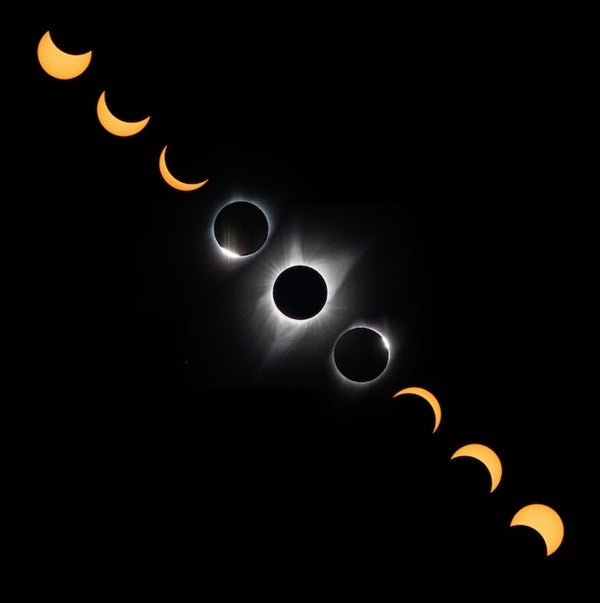
This eclipse sequence begins at upper left and ends at lower right. During this event, the Moon moves from west to east, across the Sun’s face.
During a total solar eclipse, however, we can see the Moon’s true motion as it crosses the Sun’s face from west to east. As this occurs, the Moon’s shadow follows it — moving in the same direction — and tracks a path across Earth’s surface.
NASA has created a helpful video, “Flying Around the Eclipse Shadow,” which illustrates this geometry if you’re still having trouble picturing it. You can watch it online at https://svs.gsfc.nasa.gov/4579 .
Alison Klesman Associate Editor
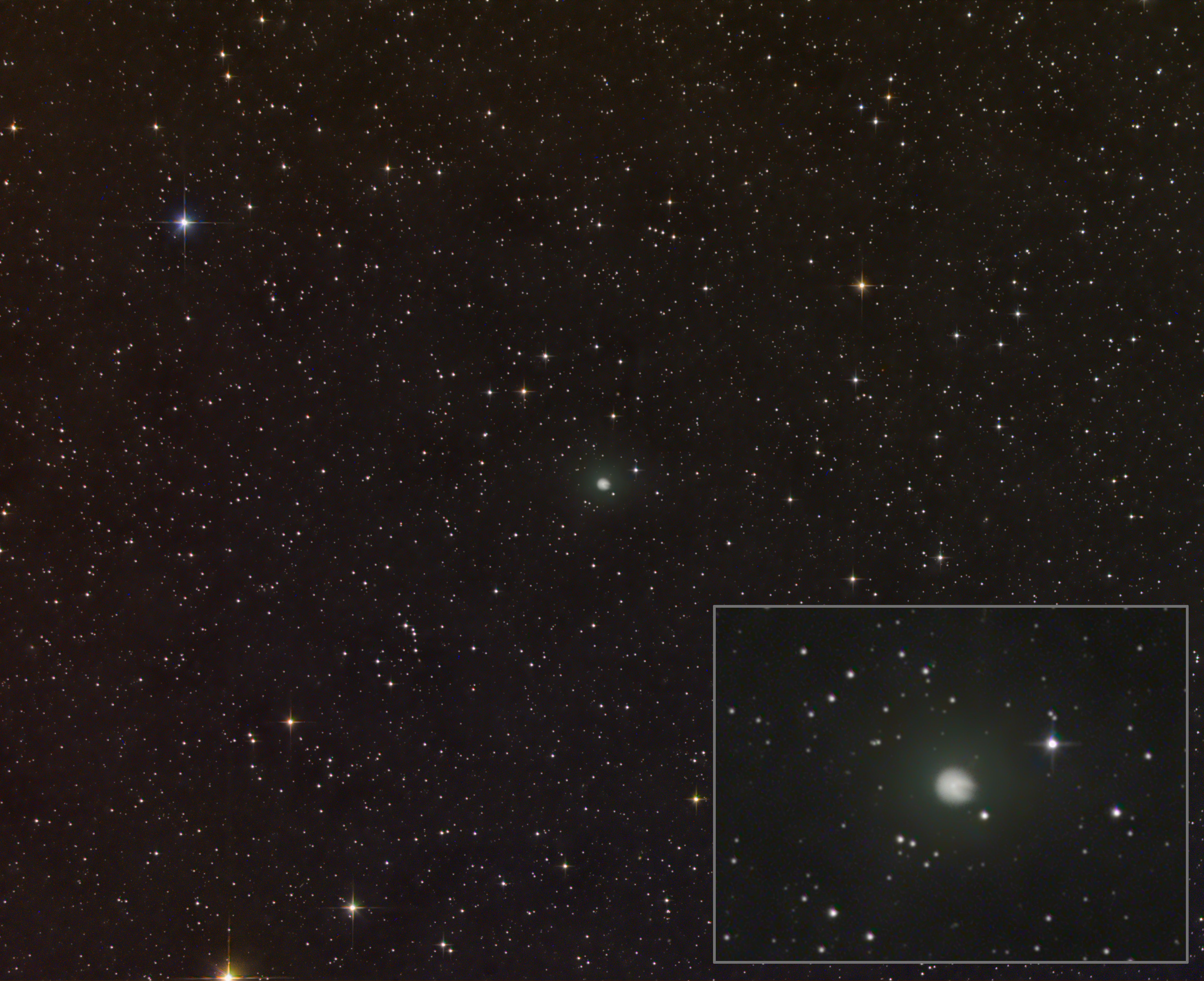
The ‘Devil Comet’ is headed our way — and that’s OK

2024 Full Moon calendar: Dates, times, types, and names
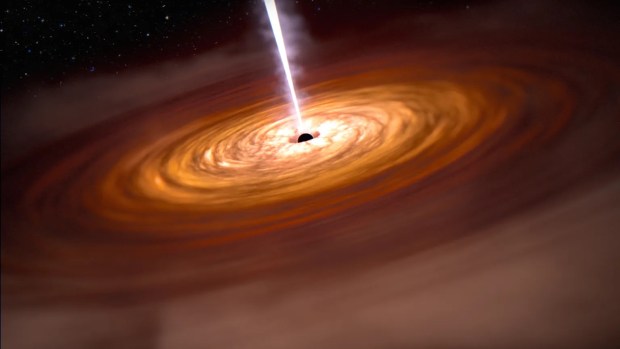
Astronomers map 1.3 million supermassive black holes

The Milky Way’s central black hole could have a hidden jet

More than a few nearby stars show signs they ate young planets

How do globular clusters remain intact for so long?

The rumblings that led to the ‘alien spheres’ probably came from a truck
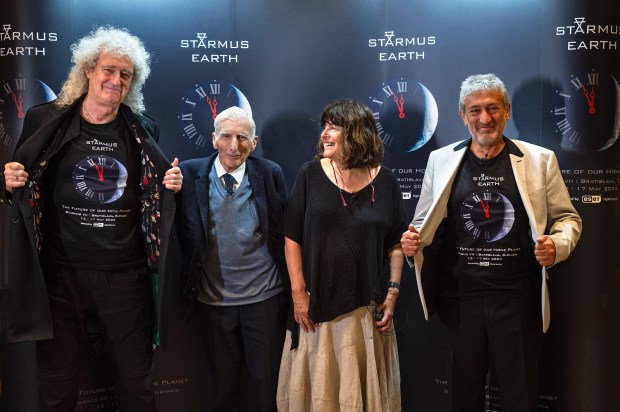
Starmus unveils its program for ‘Starmus VII, The Future of our Home Planet’
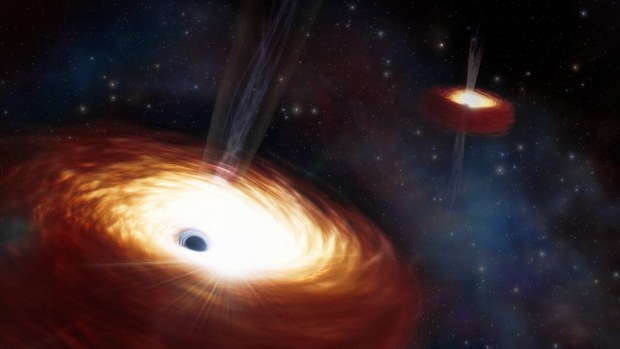
These supermassive black holes, equal to 28 billion Suns, are the heaviest ever measured

What Are the Moon’s Phases?

If you have looked into the night sky, you may have noticed the Moon appears to change shape each night. Some nights, the Moon might look like a narrow crescent. Other nights, the Moon might look like a bright circle. And on other nights, you might not be able to see the Moon at all. The different shapes of the Moon that we see at different times of the month are called the Moon’s phases .
The Moon’s appearance changes throughout the month. Credit: NASA's Scientific Visualization Studio
Why does this happen? The shape of the Moon isn’t changing throughout the month. However, our view of the Moon does change.
The Moon does not produce its own light. There is only one source of light in our solar system, and that is the Sun. Without the Sun, our Moon would be completely dark. What you may have heard referred to as “moonlight” is actually just sunlight reflecting off of the Moon’s surface.
The Sun’s light comes from one direction, and it always illuminates, or lights up, one half of the Moon – the side of the Moon that is facing the Sun. The other side of the Moon is dark.

The position of the Moon and the Sun during Each of the Moon’s phases and the Moon as it appears from Earth during each phase. Credit: NASA/JPL-Caltech
On Earth, our view of the illuminated part of the Moon changes each night, depending on where the Moon is in its orbit, or path, around Earth. When we have a full view of the completely illuminated side of the Moon, that phase is known as a full moon.
But following the night of each full moon, as the Moon orbits around Earth, we start to see less of the Moon lit by the Sun. Eventually, the Moon reaches a point in its orbit when we don’t see any of the Moon illuminated. At that point, the far side of the Moon is facing the Sun. This phase is called a new moon. During the new moon, the side facing Earth is dark.
The eight Moon phases:
🌑 New : We cannot see the Moon when it is a new moon.
🌒 Waxing Crescent : In the Northern Hemisphere, we see the waxing crescent phase as a thin crescent of light on the right.
🌓 First Quarter : We see the first quarter phase as a half moon.
🌔 Waxing Gibbous : The waxing gibbous phase is between a half moon and full moon. Waxing means it is getting bigger.
🌕 Full : We can see the Moon completely illuminated during full moons.
🌖 Waning Gibbous : The waning gibbous phase is between a full moon and a half moon. Waning means it is getting smaller.
🌗 Third Quarter : We see the third quarter moon as a half moon, too. It is the opposite half as illuminated in the first quarter moon.
🌘 Waning Crescent : In the Northern Hemisphere, we see the waning crescent phase as a thin crescent of light on the left.
The Moon displays these eight phases one after the other as it moves through its cycle each month. It takes about 27.3 days for the Moon to orbit Earth. However, because of how sunlight hits the Moon, it takes about 29.5 days to go from one new moon to the next new moon.
Here’s what the Moon looks like right now from Earth:
Use this tool to see the current Moon phase and to plan ahead for other Moon views. Credit: NASA
Interested in learning more about the Moon?
- Learn all about our Moon here .
- Learn about the types of full moons here .
- Learn why the Moon has craters here .
- Learn about lunar eclipses here .
- Make Oreo Moon phases !
Related Resources for Educators
Daily Moon Guide Moon Phases Simulation Viewed from Earth and Space Our World: Moon Phases Make a Moon Phase Calendar and Calculator
If you liked this, you may like:
Submit your questions, suggestions and criticisms here:
MoonCalc shows the motion of the Moon and Moon phase for a particular day at a particular location.
You can see the moon positions for moon rising , selected time and Moonset . The thin yellow-colored curve shows the trajectory of the moon. The closer the moon in the middle, the higher the moon above the horizon. The colors in the above time-slider shows the moonlight during the day. The moon on the time slider can be moved by mouse or with the arrow keys of the keyboard
To understand the sun and the moon even better, visit the website SunMoonTrack
With a small donation you can go to Contribute to the preservation of this website. The amount is free selectable and is done via PayPal .
Information in accordance with section 5 TMG:
Torsten Hoffmann Robert-Schumann-Str. 17 67304 Eisenberg Germany
Moon Phases Visualized – Where Is the Moon?
Local time in moscow, moon phase and position, upcoming events, how do i use this service.
- Click on Top View , Side View , or Bottom View to select a different perspective.
- Use the play buttons below the graphic to pause, fast-forward, or rewind the animation.
- To return to the real-time display, click on LIVE .
- Click on the calendar symbol to select a different date.
What is the Moon phases visualization?
The Moon phases visualization shows the positions of the Moon and Earth in real time . Distances are not to scale.
The Sun is not shown, however, the Earth's illumination indicates its position to the left. Because of the Earth's axial tilt , the Sun's assumed location shifts up and down slightly over the course of the year in this animation, appearing on the same horizontal plane as the Earth solely during the March and September equinoxes .
The circle shows the Moon's anticipated path in the upcoming weeks, including the next 3 or 4 Moon phases . As the Moon's position varies from one revolution to the next, the arrow indicating the expected lunar path may not point exactly towards the Moon's current position.
The arrows displayed after the Illumination , Distance , and Latitude values indicate their downward or upward trend.
Note: This is a beta service. We welcome feedback and error reports .
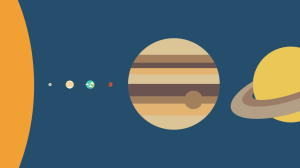
Planet Sizes and Order
How large are the planets and what is their order from the Sun?
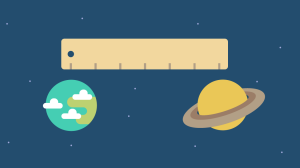
Distance, Brightness, and Apparent Size of Planets
See how far the planets are from the Sun or Earth, how bright they look, and their apparent size in the sky.

The Sky Tonight
Which planets are visible in the night sky from your location.
- For the best experience possible, please upgrade your browser. Upgrade now.
- Javascript must be enabled to use Cool Cosmos. Learn how.

- NGC 1097 (Spitzer)
- Helix (Spitzer)
- Flame Nebula (WISE)
- Galactic Center (2MASS)
- Cool Andromeda (Herschel)

- Why does the Moon follow me when I move?
How fast does the Moon travel around Earth?
- How long is a day on the Moon?
- How long does it take to travel to the Moon?
- What is a blue moon?
- What causes a ring around the Moon?
- How much would I weigh on the Moon?
- How does the Moon shine?
- How many astronauts have walked on the Moon?
- What is the temperature on the Moon?
- How small is the Moon compared to Earth?
- How far away is the Moon?
The Moon orbits Earth at a speed of 2,288 miles per hour (3,683 kilometers per hour). During this time it travels a distance of 1,423,000 miles (2,290,000 kilometers).

March 22, 2024
Earth Has More Than One Moon
Quirks of orbital mechanics make a cadre of sun-orbiting asteroids appear to be moons of Earth
By Phil Plait
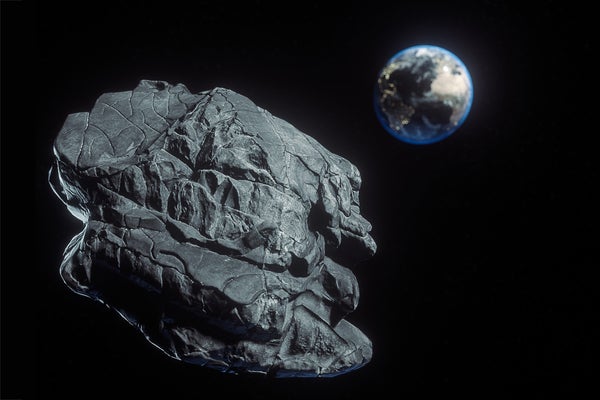
Some asteroids with solar orbits very similar to Earth’s effectively act as quasi-satellites of our planet.
Aleksandra Malysheva/Getty Images
Here’s a trick question: How many moons does Earth have? And to be clear, I mean natural satellites, not human-made ones.
I remind you, this is a trick question.
The answer is one— the moon . See? Tricky. But there’s another part to this: if you change your frame of reference and squint a little bit, the answer is more like seven . And if you broaden your mind a tad more, the number goes up even higher.

On supporting science journalism
If you're enjoying this article, consider supporting our award-winning journalism by subscribing . By purchasing a subscription you are helping to ensure the future of impactful stories about the discoveries and ideas shaping our world today.
How could that be? To explain, let’s talk about quasi-satellites and horseshoe orbits.
Orbital mechanics is a weird subject. If you have a single object—say, a planet—orbiting another single object—a star—then things are relatively simple. The orbit might be a circle or more elliptical (elongated) or a variety of other mathematical shapes. The time taken to orbit the star once is called the planet’s orbital period, and it tends to stay pretty much constant. (For a circular orbit, the speed of the planet stays constant. But if the orbit is an ellipse, the planet speeds up a bit when it’s closer to the star and slows down when it’s farther out.)
Now, let’s say there’s a second object, such as an asteroid, in orbit around the star. It, too, may travel along a circular path or a more elliptical one. And from the high and mighty view of someone looking at the system from the outside, both objects follow their paths at different speeds and with different periods.
Here’s where the weirdness pops up. Let’s say that the asteroid has an orbit that’s very similar in size to the planet’s but slightly more elliptical. Also, this object is at just the right distance from the star such that its period is almost exactly the same as the planet’s. Not only that, it also happens to be near the planet in space, too, as they orbit the sun. From our outside point of view, we see them both going around the star, each completing one orbit after the same amount of time. Sometimes the asteroid moves a little faster than the planet, however, and sometimes it does so slower, even though, on average, its orbital speed is roughly the same as the planet’s.
In a little more detail, when the asteroid is farther from the star, outside the planet’s orbit, it slows and lags behind. It then drops down closer to the star, speeds up and moves ahead of the planet. Then it falls back outward and slows, and the pattern repeats.
That’s not too strange, but if you’re looking at the asteroid from the planet’s point of view, it seems very different. From that vantage, the asteroid appears to always stick near the planet, sometimes closer to the sun and traveling ahead and sometimes farther out and moving in the reverse direction. In other words, it looks like the asteroid is going around the planet!
That’s a lot like a moon’s motion. It’s an illusion, however, because the asteroid is not really orbiting the planet. Instead it’s moving around the sun. The asteroid’s motion is aligned with the planet’s such that the space rock appears to circle the world.
An analogy to this motion is a scenario in which you are driving down the center lane of a three-lane road. Imagine a car moves ahead of you on the left, passes you, then gets all the way over into the right lane. It then slows, drops behind you, speeds up and passes you again on the left. It appears like the car is circling around you. Someone looking from the side of the road, however, will see it simply moving left and right, faster and slower.
Objects with orbits like that are known as quasi-satellites, or quasi-moons. They aren’t really moons because they actually orbit the star and not the planet—they also tend to be too far from the planet to be gravitationally bound to it.
Here’s where the trick question we started with gets really tricky: Earth has several quasi-moons that act in just this manner.
For example, 469219 Kamoʻoalewa is an asteroid about 50 meters wide in an orbit with a period of 1.002 Earth years—just around 17 hours longer than Earth’s period! Its orbit is mildly elliptical, taking it about 15 million kilometers farther from and closer to the sun than that of Earth. The asteroid’s orbit is also tipped a smidgen, by about eight degrees, with respect to Earth’s orbit. From our terrestrial point of view, Kamoʻoalewa moves as if it orbits us, just like the “circling” car described above.
There are several other objects like Kamoʻoalewa, each with its own variation on this general behavior. For example, if an asteroid is far enough ahead of Earth in its orbit, it won’t fall behind our planet despite its slowdowns and speedups. (This is a little like a car well ahead of you on the road that you never catch up to, even if its speed goes up and down a bit over time.) From our point of view, the asteroid will appear to stay in one area of the sky instead of circling around Earth like the real moon does. The asteroid 2020 PP1 is an example of this kind of quasi-moon .
Another odd example is 3753 Cruithne . This asteroid takes 364 days to travel around the sun, which means it has a somewhat shorter period than Earth does. Cruithne’s solar orbit is quite elliptical, taking it nearly 75 million km closer to and farther out from the sun. Earth’s average orbital distance from the sun is about 150 million km, so this is quite an excursion. Cruithne’s orbit is tilted quite a bit, too, by nearly 20 degrees. Unlike those other rocks, it can actually be on the opposite side of the sun as seen from Earth, yet it also occasionally approaches to within roughly 11 million km of us.
Cruithne doesn’t seem to orbit us as seen from Earth, so it’s not quite a quasi-satellite, but it gets weirder: from the vantage of our planet, the object appears to move over a wide bean-shaped path that changes position relative to Earth and the sun over time, tracing a smeared horseshoe shape every 770 years or so . While seven “true” quasi-moons of Earth are known, many more asteroids have horseshoe orbits near us .
These orbits tend not to be stable over time; gravitational tugs from the planets can alter them. Sometimes horseshoe orbits can morph into quasi-moon orbits, and vice versa.
Only a handful of such asteroids are known to currently “orbit” our planet. If an object’s orbit changes shape over time, however, it can move into a quasi-satellite or horseshoe orbit, temporarily making that object a terrestrial companion.
Quasi-satellites aren’t restricted to just Earth: Venus has the asteroid 2002 VE68, which orbits the sun with almost exactly the same period as the planet. Nicknamed Zoozve (delightfully because of a misreading used in a label on a poster of the solar system ), this asteroid has been a Cytherean quasi-moon for many millennia, but its orbit is changing and will soon move away from Venus.
Although it’s likely that other planets have quasi-moons as well, from our vantage on Earth, they’re too far away to be spotted easily. Perhaps as bigger telescopes come online, we’ll find even more of these weird kinda sorta pseudo moons.
But this situation shows once again that the firm ideas we have about things—what’s a planet, what’s a moon—are a lot more malleable than you might think. In science, it’s always best to avoid hard-and-fast definitions and allow yourself to be flexible in your thinking. Like quasi-satellites, it’s possible, over time, to change your path through life.
What direction does the moon travel around earth?
The moon travels around the earth in a counterclockwise direction. The moon moves from west to east. It moves around 12 degrees towards east in Earth's sky every day.
Looking down from the north pole, the moon travels counter clockwise around the earth.
Add your answer:
What does the moon travel around in 27 days and 7 hours?
time for the moon to travel around earth
What direction moon orbit around earth?
the moon travels from west to east in its orbit
If the force of gravitation between the earth and the moon were to suddenly disappearthe moon would start to move?
The moon is moving (around the sun) IF the Earth's gravity suddenly stopped, the moon would continue to go around the sun. IF all gravity stopped, the moon would travel in a straight line in whatever direction it was going in at the time.
What distance does the moon travel around the earth?
angel caffaso
How long does it take for the moon to travel all the way around earth?
It takes the Moon 27.322 days to go around the Earth once.
Which direction does the earth travel around the moon?
It doesn't ! The moon travels around the earth !
Does the earth travel around the moon or does the moon travel around the sun?
the moon travels around the earth,and the earth travels around the sun
The direction of the Moon revolution around the Earth is?
The direction of the moon revolution around the earth is from left to right. This is also known as anticlockwise motion.
What planet travels around moon?
There are no planets that travel around the moon. The moon travels around Earth.
Does the moon travel around the earth as the earth revolves around the sun?
Yes Yes Because the Moon is in Earth's Gravitational Pull.
If you travel from earth to moon what direction are you traveling?
"Up" at the beginning of the trip, and "down"at the end of it.
Which direction does the moon move around the earth?
it travels west to east
When does the Moon travel more faster around the earth?
The Moon's orbital speed is greatest when it is at its closest approach to the Earth.
Top Categories

Eclipse seasons: Why the lunar eclipse on March 25 occurs 2 weeks before the total solar eclipse on April 8
How and why the full 'Worm Moon' aligns for March 25's lunar eclipse and April 8's total solar eclipse.
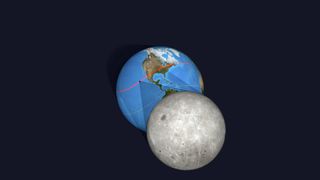
'Eclipse seasons' explained
Eclipse seasons in 2024, how the moon's orbital nodes work, what causes partial and penumbral eclipses.
On Monday, March 25, the full "Worm Moon" will cause a penumbral lunar eclipse for the night side of Earth, including North and South America, Europe, East Asia, Australia and New Zealand.
The third full moon of 2024 and the first of spring in the northern hemisphere, the "Worm Moon" — also known as the "Crow Moon" and the "Lenten Moon" — will move through the Earth 's outer shadow in space.
As well as being an interesting astronomical event, it will set up a total solar eclipse exactly two weeks later that will be seen across North America.
We're entering 2024's first (and best) "eclipse season," during which there will be two eclipses — one of the moon by the Earth and one of the sun by the moon.
- A lunar eclipse occurs during a full moon — when the Earth is between the sun and moon, blocking sunlight from reaching the lunar surface.
- A solar eclipse occurs during a new moon — when the moon is between the Earth and the sun.
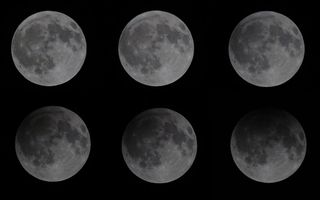
Every 173 days, for between 31 and 37 days, the moon intersects (or almost intersects) the ecliptic—the apparent path of the sun through our daytime sky. The ecliptic is also the plane of Earth's orbit of the sun. What results is a short season during which two — and occasionally three — solar and lunar eclipses can occur.
In 2024, there will be two eclipse seasons each featuring two solar eclipses and two lunar eclipses:
Eclipse season 1
- March 25 : a penumbral lunar eclipse of the "Worm Moon" (North and South America, Europe, East Asia, Australia and New Zealand).
- April 8 : a total solar eclipse (parts of Mexico, the U.S. and Canada).
Eclipse season 2
- September 18 : a partial lunar eclipse of the "Harvest Moon" (Europe, Asia, Africa, North America, South America, Pacific, Atlantic, Indian Ocean, Arctic, Antarctica.)
- October 2 : an annular solar eclipse (Easter Island, Rapa Nui, Chile and Argentina).
Although there is no third eclipse in 2024's second eclipse season, there so nearly is. According to timeanddate, an "almost lunar eclipse" will (won't!) occur on October 17 when the full "Hunter's Moon" just misses moving through Earth's shadow. It's a meaningless fact, visually, but it helps demonstrate how eclipse seasons work. It will miss because the moon will have been at its ascending node the day before, according to Astropixels .
The moon's orbital nodes are why there isn't a solar or lunar eclipse every month.

The moon's orbit of Earth is tilted by 5 degrees with respect to the ecliptic. That guarantees that there usually isn't a solar or lunar eclipse in any given month, but it also ensures that they must happen occasionally.
For one to occur, the moon must reach its new or full phase while it crosses the ecliptic. These two places are called the ascending node and the descending node.
The moon reaches those two nodes at different times every month. It usually does so when it's not either new or full, so it isn't in a position to eclipse or be eclipsed. Only during an eclipse season does the moon arrive at, or very close to, these nodes at the perfect time to cause an eclipse. The result is a short season during which two (and sometimes three) solar and lunar eclipses can occur, one after another, two weeks apart.
Slight eclipses — a partial solar or lunar eclipse and a penumbral lunar eclipse — occur during eclipse season when the moon reaches a node just a few hours or a day too early or late. On these occasions, it misses its target, either eclipsing only part of the sun or moving through Earth's outer shadow.
Either the new moon is slightly above or below the sun, and the full moon is above or below Earth's shadow. Only when it reaches a node at precisely the right time does it cause a total solar eclipse or a total lunar eclipse.
That's what makes Monday, April 8, such a special day for North America — and why you should, if possible, travel into the path of totality. Only then will you see, with your own naked eyes, the sun's majestic, spiky white corona revealed in a dark sky.
Note: Only look at the partial phases of any solar eclipse with proper eye protection, which means solar eclipse glasses. Lunar eclipses are completely safe at all times.
Related: How to observe the sun safely (and what to look for)
Join our Space Forums to keep talking space on the latest missions, night sky and more! And if you have a news tip, correction or comment, let us know at: [email protected].
Get the Space.com Newsletter
Breaking space news, the latest updates on rocket launches, skywatching events and more!

Jamie is an experienced science, technology and travel journalist and stargazer who writes about exploring the night sky, solar and lunar eclipses, moon-gazing, astro-travel, astronomy and space exploration. He is the editor of WhenIsTheNextEclipse.com and author of A Stargazing Program For Beginners , and is a senior contributor at Forbes. His special skill is turning tech-babble into plain English.
Total solar eclipse 2024: Live updates
Lego Education Eclipse Collection teaches students about April 8 total solar eclipse
Life as we know it could exist on Venus, new experiment reveals
- Kehk in a MiG I've never actually heard "total lunar eclipse"; instead "umbral lunar eclipse". Nevertheless, either is correct. Reply
- View All 1 Comment
Most Popular
By Fran Ruiz January 29, 2024
By Fran Ruiz January 26, 2024
By Conor Feehly January 05, 2024
By Keith Cooper December 22, 2023
By Fran Ruiz December 20, 2023
By Fran Ruiz December 19, 2023
By Fran Ruiz December 18, 2023
By Tantse Walter December 18, 2023
By Robert Lea December 05, 2023
By Robert Lea December 04, 2023
By Robert Lea December 01, 2023
- 2 Giant Mars asteroid impact creates vast field of destruction with 2 billion craters
- 3 365 days of satellite images show Earth's seasons changing from space (video)
- 4 Still alive! Japan's SLIM moon lander survives its 2nd lunar night (photo)
- 5 Total solar eclipse 2024: Live updates
Follow a mile-by-mile map of the total solar eclipse
On April 8, the sun, moon and Earth will enter the precise alignment of a total solar eclipse. The moon will block the sun, casting a shadow across a strip of North America from the Pacific Ocean west of Mexico, through 15 U.S. states, to the Atlantic off Canada.
This strip, roughly 4,000 miles long and 115 miles wide, is called the path of totality. For a short while, everyone and everything in this path will experience midday darkness.
The beginning

2:07-2:11 p.m.
Total time eclipsed

Historic cloud coverage
The moon’s shadow makes landfall in Mexico at 2:07 p.m. Eastern time, casting the first region into darkness. Here, darkness lasts for about four minutes near the center of the path, but decreases in time toward the edges.
A populous path
Nearly 32 million people live in the path of totality this year. The eclipse crosses the homes of more people in Texas alone than the 2017 eclipse crossed nationally.
Eagle Pass, Tex.
2:27-2:31 p.m.
The eclipse crosses into the United States in Eagle Pass, Tex. The border town will be dark for 4 minutes and 23 seconds — over a minute longer than the 2017 eclipse lasted anywhere.
2:35-2:39 p.m.
A 195-mile stretch of Interstate 35 between Austin and Dallas is in the path. Texas officials are already warning drivers not to stop on roadways during the eclipse. You'd have to drive 1,950 miles an hour to keep up with the moon's shadow.
2:40-2:44 p.m.
The nation’s second busiest airport, Dallas Fort Worth International, lies in the path of totality. The airport said flights will not be affected. Some airlines are even offering special flights timed to the eclipse to extend your time in totality.
Hot Springs National Park
2:48-2:53 p.m.
In Arkansas lies Hot Springs National Park, one of two national parks in the path of totality. Parks across the country, even those not in totality, are planning livestreams, shows and talks for the eclipse.
Ozark National Scenic Riverways
2:55-2:59 p.m.
Just like many humans, Smokey Bear is also traveling into the path of totality. A 97-foot-tall hot air balloon bearing Smokey’s face is traveling from New Mexico to the Ozarks to remind visitors how to prevent wildfires.
Carbondale, Ill.
2:59-3:03 p.m.
Just past the Mississippi River is Carbondale, Ill., which has billed itself the “Eclipse Crossroads of America” because it sat in the path of the 2017 eclipse.
Check the forecast
At this point in the path, the weather forecast becomes critical for eclipse seekers. The areas from here on are typically cloudier in April than the previous areas, according to an analysis of cloud cover data.
3:13-3:17 p.m.
The eclipse crosses the Cleveland Guardians’s baseball stadium on the team's home opener at about 3:15 p.m. But rather than be interrupted by nearly four minutes of darkness, the game will start two hours after the moon’s shadow passes by.
An influential eclipse
The eclipse next passes over land historically populated by the Haudenosaunee, also known as the Iroquois. Researchers disagree on when the Iroquois Confederacy was established. But tribal oral history indicates the Seneca joined the alliance shortly after witnessing a solar eclipse, which researchers suggest occurred in this area in 1142.
Burlington, Vt.
3:25-3:28 p.m.
About 13,000 schools are in the path of totality, including more than 300 in Vermont. Some plan to incorporate experiencing the eclipse into their lessons, but others plan to let kids out of school early to help avoid traffic bottlenecks.
Piscataquis County, Maine
3:30-3:34 p.m.
The final 150 miles of the Appalachian Trail lie in the path of totality, including Mount Katahdin, the highest point in Maine.
Gulf of St. Lawrence
3:32-3:35 p.m.
The eclipse finally passes over Prince Edward Island before its last hurrah over Newfoundland in Canada, completing its North American journey in a bit more than two hours.
Totality at 2:07 p.m. EDT
About this story
Population calculated by summing 2020 population estimates in 30 arc-second grid cells within the path of totality. Distance covered calculated from the centerline of the path.
Sources: NASA, European Space Agency, U.S. Geological Survey, Natural Earth Data, Census Bureau, OpenStreetMap, GOES imagery analysis by University of Wisconsin at Madison Cooperative Institute for Meteorological Satellite Studies, Center for International Earth Science Information Network
Szu Yu Chen and Lauren Tierney contributed to this report. Editing by Emily M. Eng, Tim Meko and Victoria Jaggard. Copy editing by Angela Mecca.
Auroras and a Worm Moon Eclipse: Celestial Events Light Up Sky Ahead of April Total Eclipse
A head of next month’s much-anticipated total solar eclipse , the night sky was illuminated late Sunday and early Monday by a flurry of other celestial activity over the weekend.
First, a Friday outburst of plasma, or coronal mass ejection , from the sun’s outermost layer caused a “severe” geomagnetic storm that was observed by the National Oceanic and Atmospheric Administration (NOAA) on Sunday evening. While such storms could have effects on telecommunications technology , few were observed. But the celestial activity did pave the way for a stunning spectacle. Auroras, also known as northern or southern lights, are naturally-occurring light displays caused by disruptions in the Earth’s magnetic field. While some resultant auroras have already been spotted, such as in Fairbanks, Alaska, on Sunday evening , the geomagnetic storm’s effects are expected to carry on through Monday, with Australia and even some northern U.S. states potentially getting a glimpse of the show in the sky.
Sunday night also saw the rise of the first full moon of spring, commonly referred to as the “worm moon” or “sugar moon” by various cultures. Thanks to the “moon illusion,” according to The Old Farmer’s Almanac , the worm moon seemed larger than usual as it appeared closer to the horizon and could be viewed in comparison to buildings and other landmarks on the ground. This year’s worm moon reached peak illumination at around 3:00 a.m. Eastern time on Monday.
This year’s worm moon is extra special because it also quietly slipped behind the Earth’s outer shadow for a penumbral lunar eclipse, visible in much of the world as a slight dimming of the moon. The moon was scheduled to enter the shadow at 12:53 a.m. ET, according to NASA , reaching its greatest eclipse at 3:13 a.m. when 96% of the moon was in partial shadow, and exiting the shadow at 5:32 a.m. Eclipses tend to come in pairs during what NASA calls “eclipse seasons,” about 35-day periods that come twice a year near the spring and fall equinoxes—the 2024 spring equinox was on March 20—when the sun, the moon, and the Earth are aligned. While no precautions were necessary to view the penumbral eclipse, experts warn that proper eyewear will be needed to take in the more rare and more spectacular total solar eclipse on April 8.
Read More: The ‘Devil Comet’ Will Be a Heavenly Co-Star During the Eclipse
Below are some photos and videos posted on social media that users claim to have taken of the past weekend’s celestial events:
March 2024 auroras
Stunning aurora borealis in Trondheim this evening , localized entirely within my kitchen! #trondheim #aurora pic.twitter.com/NhVlLI2cLO — Oliver Creese (@Oliver_Creese) March 23, 2024
I know there's not a volcano in the background, but the skyline of Reykjavik is pretty cool too. Dusk at Öskjuhlíð this evening just after the G4 storm. #aurora #northernlights #iceland pic.twitter.com/OwoKK6bCds — jessica poteet 🌻 (@MarkDownHandsUp) March 25, 2024
Some more shots of the aurora last night from my iPhone—what a show! pic.twitter.com/pFRyIEwDim — Vincent Ledvina (@Vincent_Ledvina) March 23, 2024
March 2024 “worm moon”
The full Worm Moon rises over the Chesapeake Bay. The moon shines through the rigging of The Pride of Baltimore II at City Dock in Annapolis. Enjoy. Thanks for being you and chasing the moon with me. pic.twitter.com/CxlLM5rTGr — Paul W. Gillespie (@pwgphoto) March 25, 2024
Tonight’s Full Moon (Worm Moon) rising above Reading Pagoda in Pennsylvania. Quite the spectacle. #wormMoon #FullMoon pic.twitter.com/chnz4vvoHe — Dan Martland (@DanTVusa) March 25, 2024
The full Worm Moon rises behind the skyline of midtown Manhattan and the Empire State Building as the sun sets in New York City, Sunday evening #nyc #newyork #newyorkcity #sunset @empirestatebldg #WormMoon #moon #fullmoon pic.twitter.com/gvGJiA6enN — Gary Hershorn (@GaryHershorn) March 25, 2024
This morning's almost full moon (99.3%) moonset with the DC Temple in Kensington, Maryland #moon #wormmoon #moonphotography #waxinggibbous #MDinFocus #DCTemple #MormonTemple #visitmoco #maryland #NikonNoFilter #NikonZ8 #thephotohour #stormhour @spann @capitalweather pic.twitter.com/hp2KsvfSxj — Dave Lyons (@insiteimage) March 24, 2024
Worm moon over Seattle, WA 2024. pic.twitter.com/YXmXxX3qjf — Kristin L. Raught Photography (@KristinLRaught) March 25, 2024
March 2024 penumbral eclipse
The penumbral lunar eclipse over Cleveland. Not much difference but this was at its peak around 3:13am. This is 6 minutes sped up to :30 seconds. #PenumbralLunarEclipse #Lunareclipse pic.twitter.com/GkIkkiKRFI — Mike Vielhaber (@MVielhaber) March 25, 2024
A short glimpse of Penumbral Lunar Eclipse before the clouds took over #infinitegrids @CityofSurrey @VIAwesome @DailyHiveVan @GlobalBC @globalnews @CBCVancouver @CBCNews @CTVVancouver @VancouverSun @ScienceVancity @SurreyNowLeader pic.twitter.com/T39hFqO2Ro — Srinivas Raghavan (@infinitegrids1) March 25, 2024
More Must-Reads From TIME
- Jane Fonda Champions Climate Action for Every Generation
- Biden’s Campaign Is In Trouble. Will the Turnaround Plan Work?
- Why We're Spending So Much Money Now
- The Financial Influencers Women Actually Want to Listen To
- Breaker Sunny Choi Is Heading to Paris
- Why TV Can’t Stop Making Silly Shows About Lady Journalists
- The Case for Wearing Shoes in the House
- Want Weekly Recs on What to Watch, Read, and More? Sign Up for Worth Your Time
Contact us at [email protected]
You May Also Like

Moon Phases
Overview from space.
Imagine you’re in a spaceship, traveling away from Earth. As you sail onward, you see our planet and its Moon locked together in their endless, circling, gravitational embrace. Your distant view gives you a unique perspective on the Moon that can be hard to visualize from the ground, where the Moon appears to sweep through the sky as an ever-changing globe of light.
From your astronaut’s viewpoint, you can see that the Moon is an average of 238,855 miles (384,399 km) from Earth, or about the space that could be occupied by 30 Earths. It travels around our planet once every 27.322 days in an elliptical orbit, an elongated circle. The Moon is tidally locked with Earth, which means that it spins on its axis exactly once each time it orbits our planet. Because of this, people on Earth only ever see one side of the Moon. We call this motion synchronous rotation.
Daily Moon Guide
Check out NASA's interactive map for observing the Moon each day of the year.
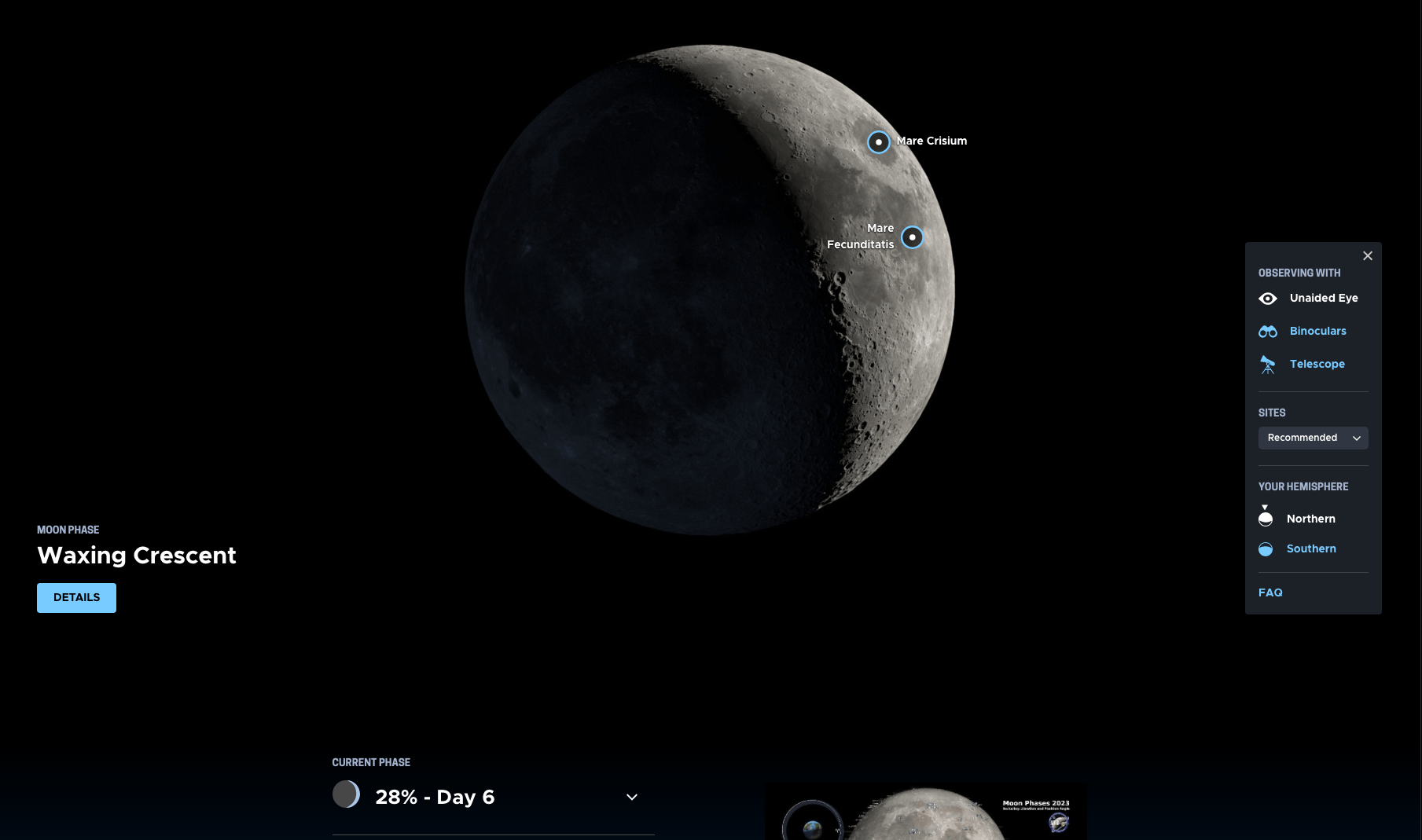
In our entire solar system, the only object that shines with its own light is the Sun. That light always beams onto Earth and Moon from the direction of the Sun, illuminating half of our planet in its orbit and reflecting off the surface of the Moon to create moonlight.
Like Earth, the Moon has a day side and a night side, which change as the Moon rotates. The Sun always illuminates half of the Moon while the other half remains dark, but how much we are able to see of that illuminated half changes as the Moon travels through its orbit.
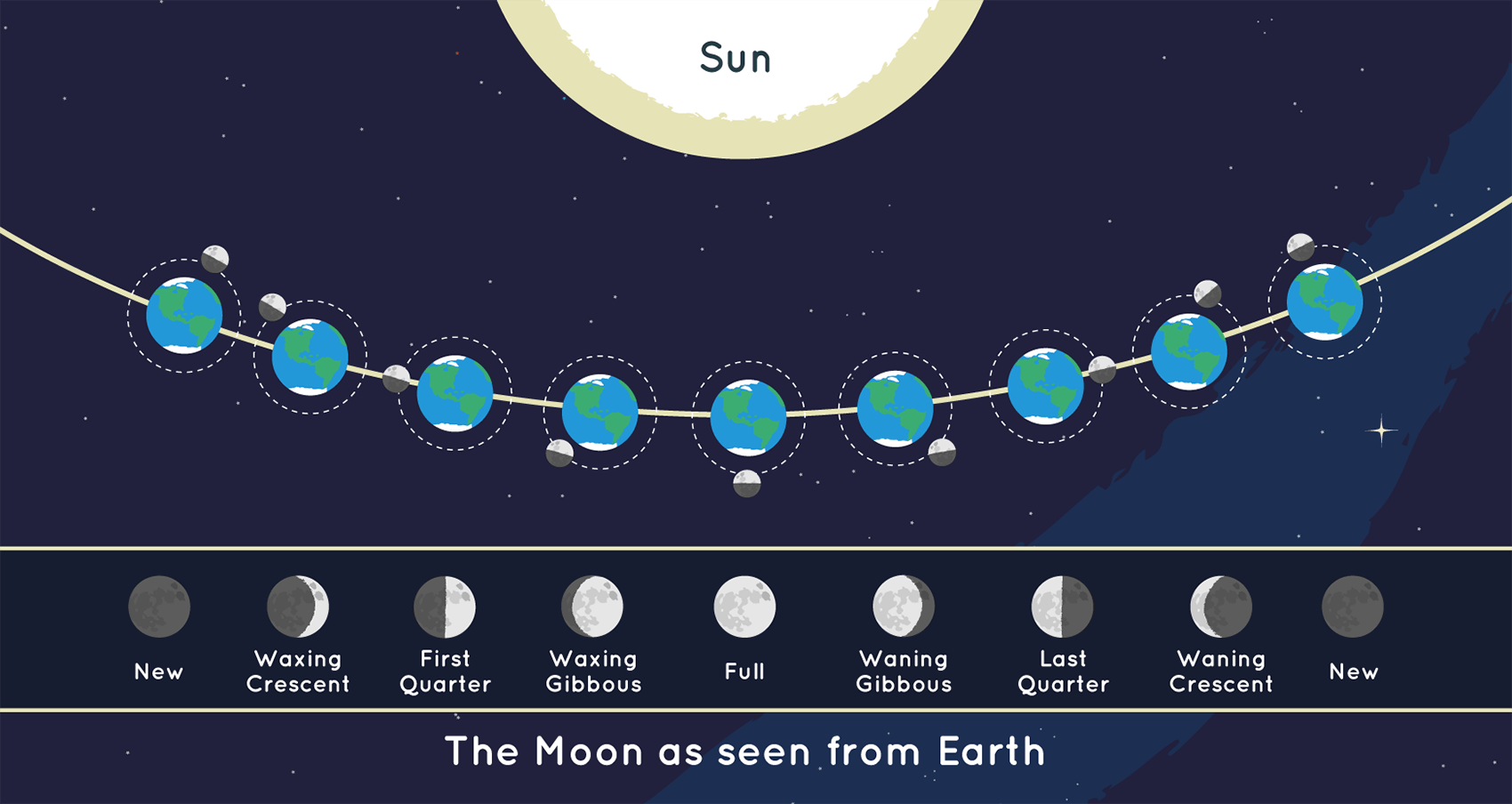
Let’s take a look at the individual phases, and how the movements of the Moon and Sun appear to us as we watch from the Northern Hemisphere on Earth:
This is the invisible phase of the Moon, with the illuminated side of the Moon facing the Sun and the night side facing Earth. In this phase, the Moon is in the same part of the sky as the Sun and rises and sets with the Sun. Not only is the illuminated side facing away from the Earth, it’s also up during the day! Remember, in this phase, the Moon doesn’t usually pass directly between Earth and the Sun, due to the inclination of the Moon’s orbit. It only passes near the Sun from our perspective on Earth.
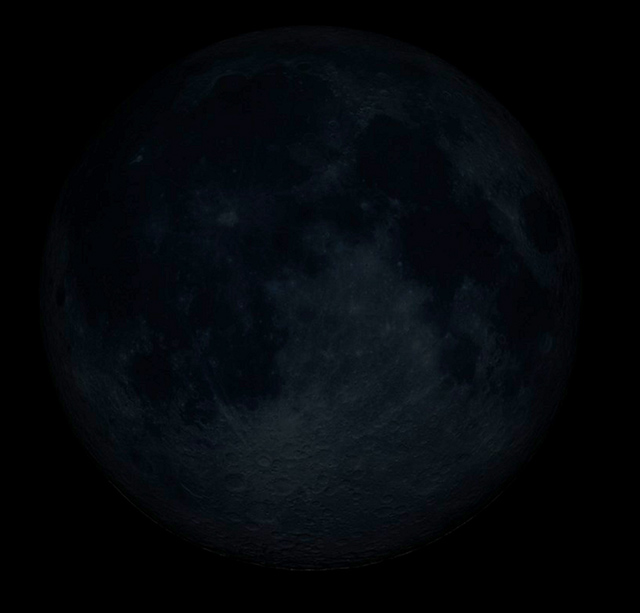
Waxing Crescent
This silver sliver of a Moon occurs when the illuminated half of the Moon faces mostly away from Earth, with only a tiny portion visible to us from our planet. It grows daily as the Moon’s orbit carries the Moon’s dayside farther into view. Every day, the Moon rises a little bit later.
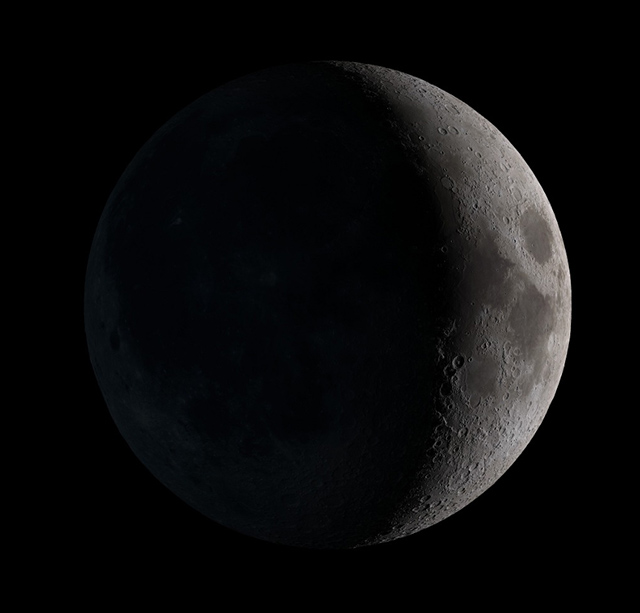
First Quarter
The Moon is now a quarter of the way through its monthly journey and you see half of its illuminated side. People may casually call this a half moon, but remember, that’s not really what you’re witnessing in the sky. You’re seeing just a slice of the entire Moon ― half of the illuminated half. A first quarter moon rises around noon and sets around midnight. It’s high in the sky in the evening and makes for excellent viewing.
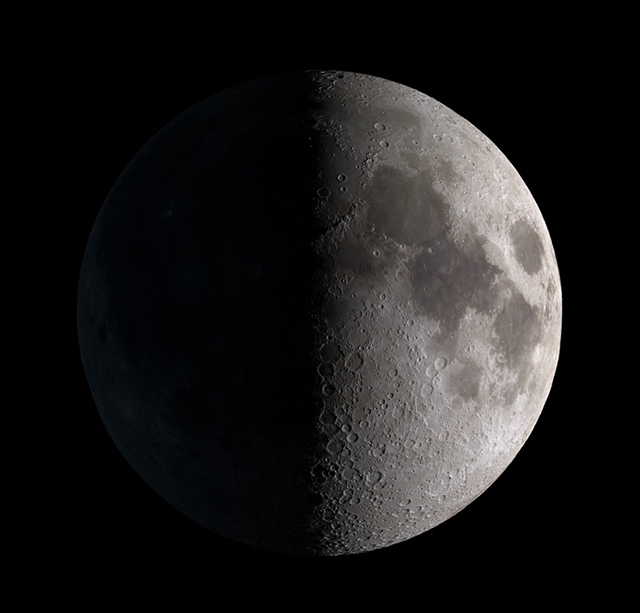
Waxing Gibbous
Now most of the Moon’s dayside has come into view, and the Moon appears brighter in the sky.
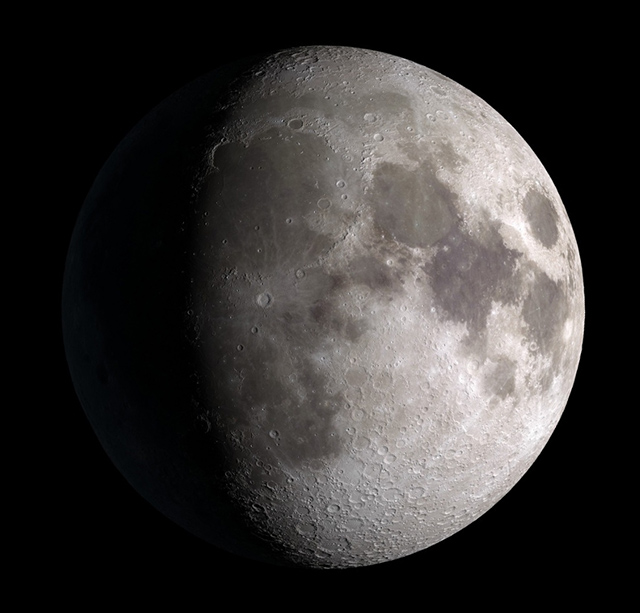
This is as close as we come to seeing the Sun’s illumination of the entire day side of the Moon (so, technically, this would be the real half moon). The Moon is opposite the Sun, as viewed from Earth, revealing the Moon’s dayside. A full moon rises around sunset and sets around sunrise. The Moon will appear full for a couple of days before it moves into…

Waning Gibbous
As the Moon begins its journey back toward the Sun, the opposite side of the Moon now reflects the Moon’s light. The lighted side appears to shrink, but the Moon’s orbit is simply carrying it out of view from our perspective. The Moon rises later and later each night.
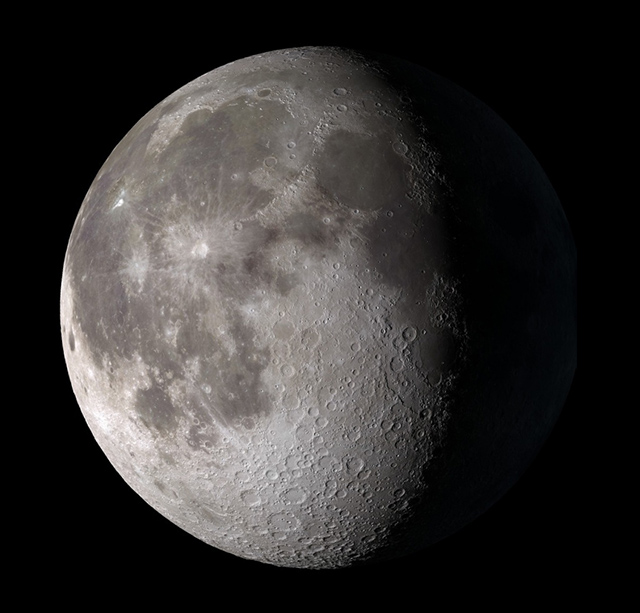
Last Quarter
The Moon looks like it’s half illuminated from the perspective of Earth, but really you’re seeing half of the half of the Moon that’s illuminated by the Sun ― or a quarter. A last quarter moon, also known as a third quarter moon, rises around midnight and sets around noon.
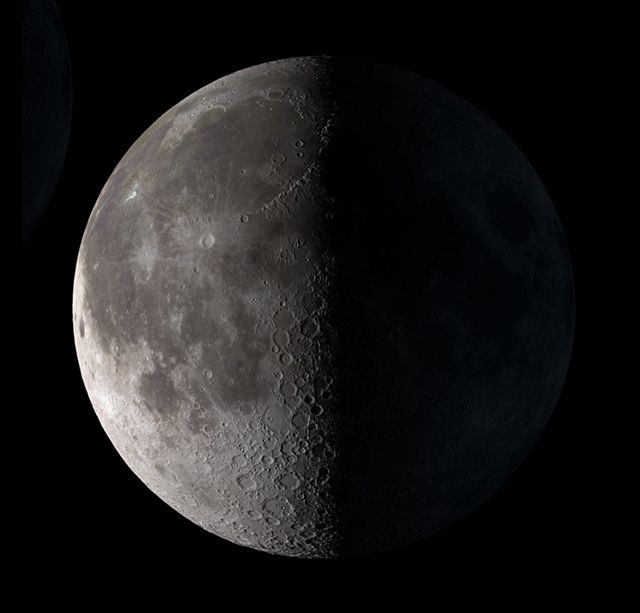
Waning Crescent
The Moon is nearly back to the point in its orbit where its dayside directly faces the Sun, and all that we see from our perspective is a thin curve.
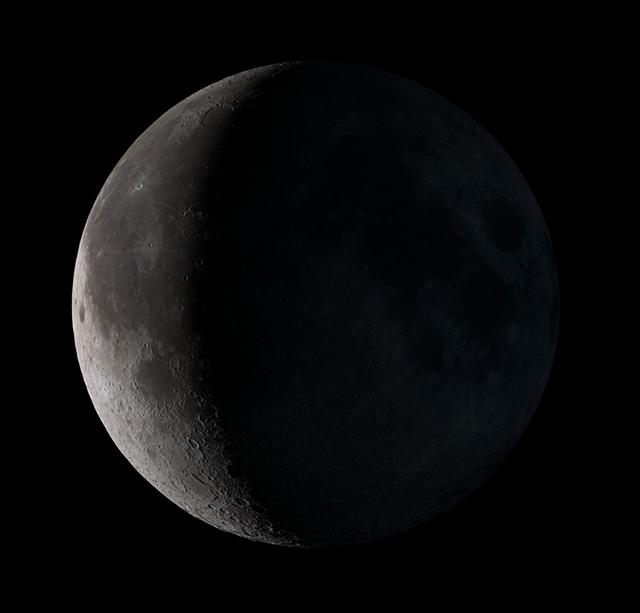
Our Wobbly Moon
When we think of the way the Moon seems to change over the course of a month, we think of phases. But frequent Moon observers know that the Moon also appears to twist, nod, and roll slightly during its journey across the sky, allowing us to peek around the Moon's shoulder and catch glimpses of the farside. This phenomenon is called libration.
Because the Moon's orbit is not perfectly circular, its distance from Earth and its speed in orbit both change slightly throughout the month. The Moon’s rate of rotation around its own axis, though, always stays the same.
When the Moon is at its closest to Earth and moving most quickly along its orbital path, the Moon itself doesn’t rotate quite fast enough to keep entirely the same side facing us, and we get to see a little more of the eastern side of the Moon. When the Moon is farthest from Earth and orbiting at its slowest, its rotation gets a little ahead, and we see a bit more of its western side. We call this motion “libration in longitude.”
The 5 degree tilt of the Moon’s orbit also causes it to appear to nod, as though it were saying “yes.” The tilt sometimes brings the Moon above Earth’s northern hemisphere, and sometimes below Earth’s southern hemisphere, allowing us to see slightly more of the northern or southern hemispheres of the Moon. We call this motion “libration in latitude.”
Finally, the Moon appears to tilt back and forth like a metronome. The tilt of the Moon’s orbit contributes to this, but it’s mostly due to the tilt of our Earth. Earth has a tilt of 23.5 degrees on its axis, which means that when we observe the Moon from Earth, it’s a little like we’re standing sideways on a ramp. If you look left, the ramp slopes up. If you look right, the ramp slopes down. In front of you, the horizon looks higher on the right and lower on the left. If you turn around, the horizon appears to tilt the opposite way.
The tilted ramp works the same as the tilted “platform” of the Earth beneath our feet. Every two weeks, we have to look in the opposite direction to see the Moon, and the ground beneath our feet is then tilted the opposite way as well.
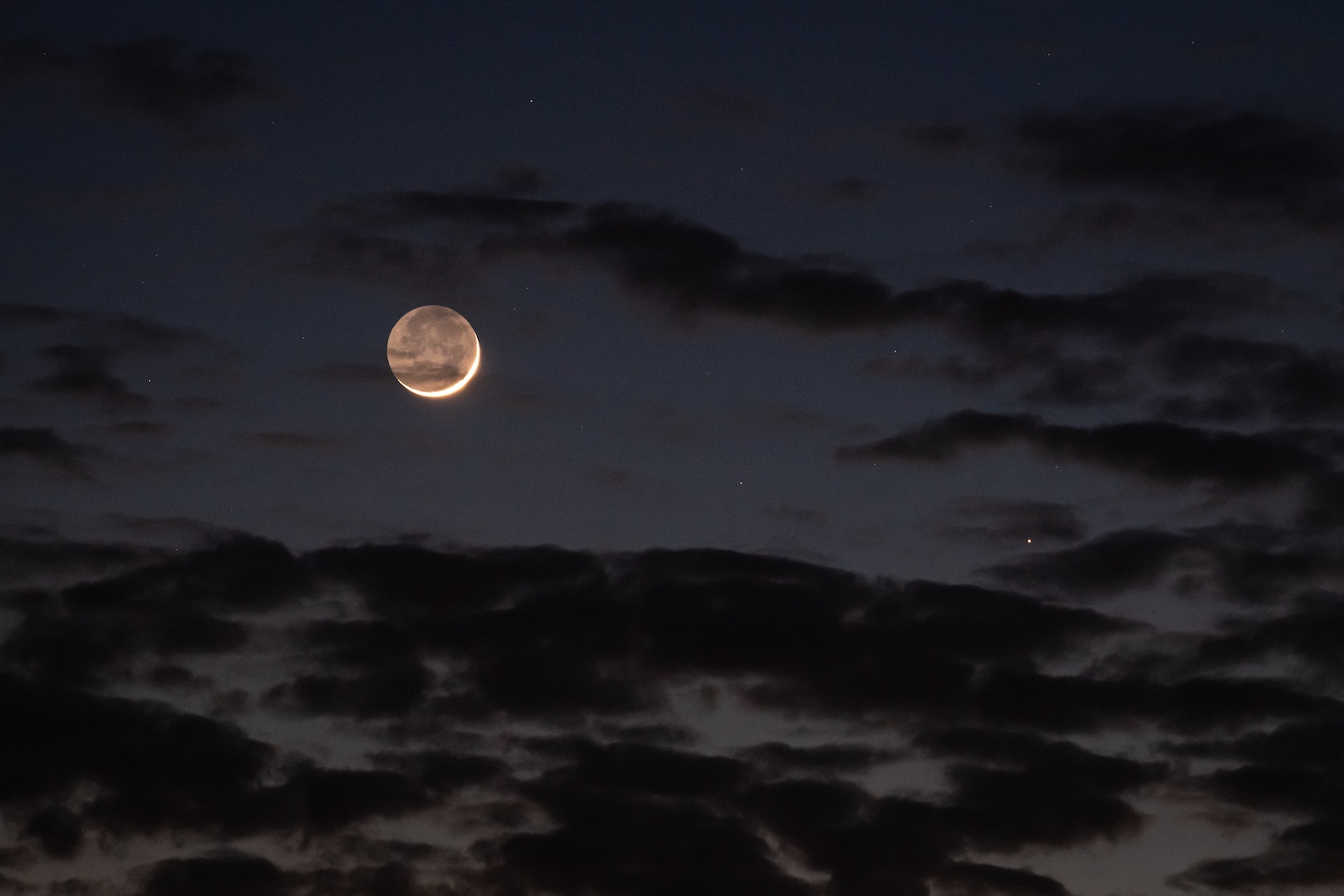
Sometimes, when the Moon is in one of its crescent phases, we can still see the darkened area of the Moon’s nearside shining dimly. This effect is caused by the Sun’s light reflecting off Earth’s surface onto the face of the Moon. Because Earth at that point in its orbit is nearly full from the Moon’s perspective, the light it reflects, called earthshine, is bright enough to dimly illuminate the darkened surface.
Daytime Moons
Though the Moon is often thought of as a nighttime visitor, it’s also visible during the day as a faint, pale presence. The best times to see a daytime Moon are perhaps during the first and last quarter phases, when the Moon is high enough above the horizon and at about 90 degrees from the Sun in the sky. This helps make the Sun’s reflected light bright enough to see as it reflects off of the Moon. The Moon can be seen in the daylit sky at any phase except for the new moon, when it’s invisible to us, and full moon, when it’s below the horizon during the day. The crescent through quarter phases are high in the sky during the day, but the daytime gibbous phases can be glimpsed only just before the Sun sets.
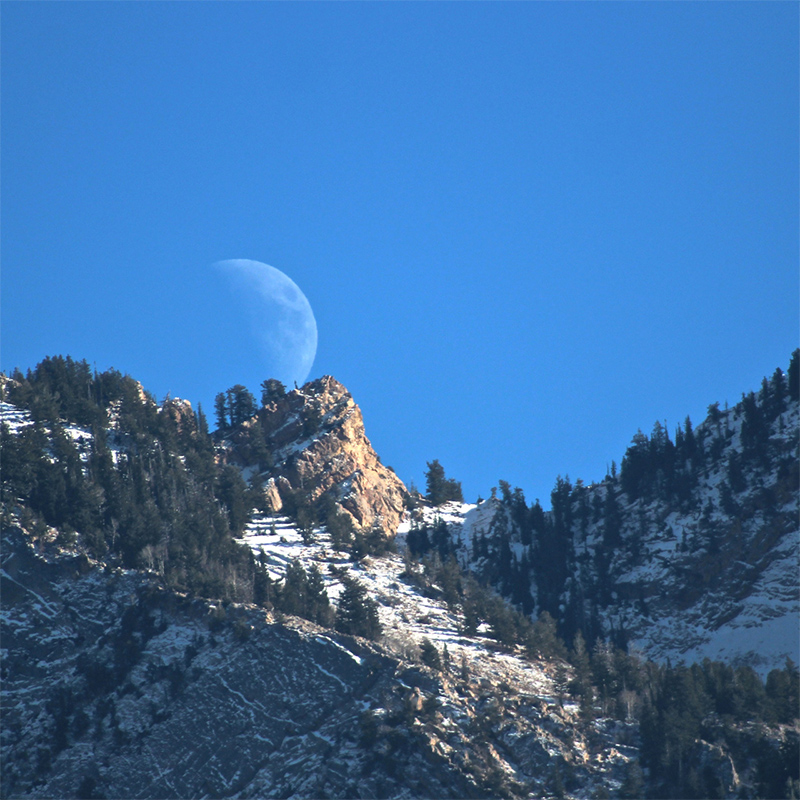
Discover More Topics From NASA

Lunar Discovery and Exploration
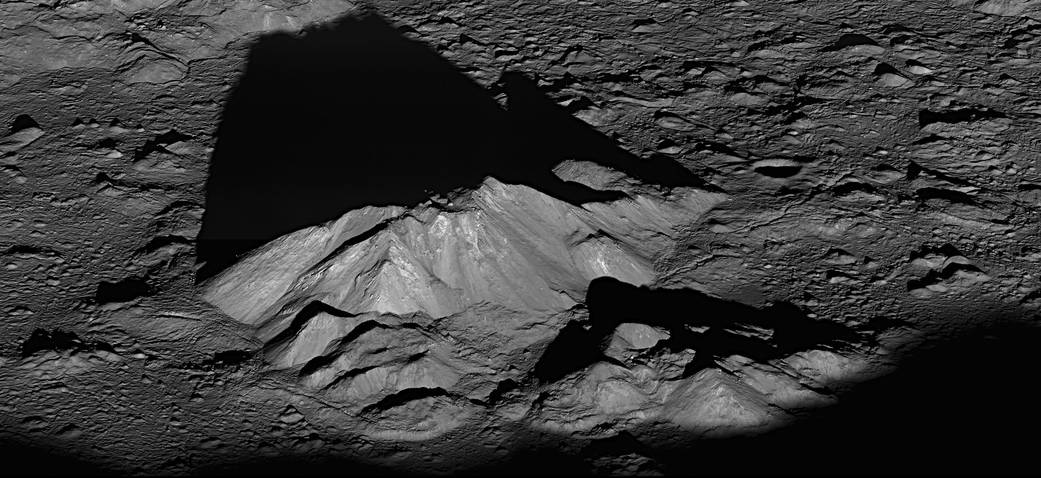
Skywatching
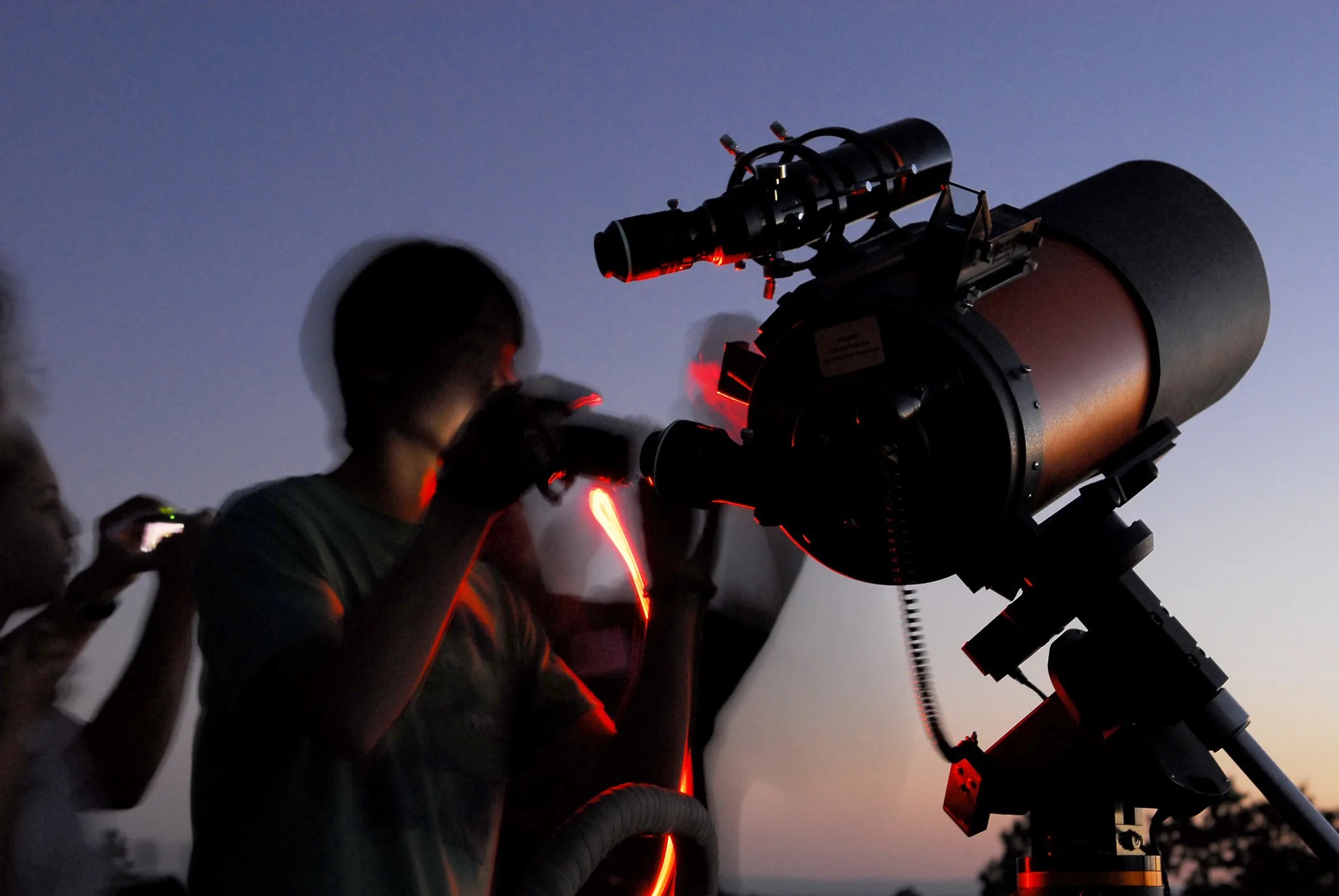
Maps of the April 2024 Total Solar Eclipse
By Jonathan Corum
On April 8, the moon will slip between the Earth and the sun, casting a shadow across a swath of North America: a total solar eclipse.
By cosmic coincidence, the moon and the sun appear roughly the same size in the sky. When the moon blocks the glare of the sun, the sun’s outer atmosphere, or corona, will be briefly visible.
Below are several maps of the eclipse’s path as well as images of what you might experience during the event.
Where Can I See the Total Eclipse?
The eclipse will begin at sunrise over the Pacific Ocean, then cut through Mexico and cross the United States from Texas to Maine. Most of North America will see a partial eclipse, but viewers within the deepest shadow — a band sliding from Mazatlán, Mexico, to the Newfoundland coast near Gander, Canada — will experience a total solar eclipse.
Percentage of
the sun obscured
during the eclipse
Indianapolis
Little Rock
San Antonio
Viewers inside the path of the total eclipse may notice a drop in temperature , a lull or shift in the wind , the appearance of bright planets in the sky, and the quieting of birds and other wildlife.
Many cities lie inside the path of the total eclipse, as shown below, the width of which varies from 108 miles to 122 miles.
20% partial eclipse
NEWFOUNDLAND
SASKATCHEWAN
Fredericton
Minneapolis
San Francisco
90% partial eclipse
Los Angeles
Mexico City
EL SALVADOR
Explore our interactive cloud outlook for eclipse viewing times and average cloud data at your location.
What Will I See?

A composite image of the 2017 solar eclipse over Madras, Ore.
Aubrey Gemignani/NASA
If the sky is clear, viewers in the path of the total eclipse should see a “diamond ring” effect a few seconds before and after the total eclipse, as the edge of the sun slips in and out of view.

The “diamond ring” effect during the 2017 solar eclipse.
Rami Daud/NASA, Alcyon Technical Services
The sun’s outer atmosphere, or corona, is normally hidden by the sun’s glare. These tendrils and sheets of gas, heated to a million degrees Fahrenheit or more, are in constant motion and shaped by the sun’s swirling magnetic field.

The sun’s corona during the 2017 solar eclipse.
The sun is relatively active this year and is nearing the expected peak of its 11-year solar cycle . Researchers at Predictive Science are using data about the sun’s magnetic field to predict and model a dramatic corona for the April eclipse.

A prediction of how the sun’s corona might appear during the April 8 total eclipse.
Predictive Science
What Colors Should I Wear?
As the sky darkens, light-sensitive cells in human eyes become more sensitive to blue and green hues than to reds and oranges. This shift in color perception is known as the Purkinje effect , after a 19th-century Czech scientist, and is typically seen at twilight.

Watching the 2017 total eclipse at Southern Illinois University.
Andrea Morales for The New York Times
To take advantage of the Purkinje effect, wear green clothes or a contrasting combination of greens and reds. Blue-green colors (shorter wavelengths) will appear brighter, while red colors (longer wavelengths) will appear to recede into the darkness.
What If I Miss It?
The next two total solar eclipses in the United States won’t occur until 2044 and 2045 . But eclipse chasers might catch one in 2026 in Greenland, Iceland and Spain; 2027 along the coast of Northern Africa; 2028 in Australia and New Zealand; or 2030 across Southern Africa and Australia.

A Total Solar Eclipse Is Coming. Here’s What You Need to Know.
These are answers to common questions about the April 8 eclipse, and we’re offering you a place to pose more of them.
By Katrina Miller

What’s the Cloud Outlook for Eclipse Day? See if History Is on Your Side.
April 8 could be your best opportunity to see a total solar eclipse for decades. But if clouds fill the sky, your shot at seeing the spectacle could be lost.
By Josh Katz, K.K. Rebecca Lai and William B. Davis
- Share full article
Advertisement

What time will the March 2024 Lunar Eclipse be most visible? How can you see it?
The Lunar Eclipse will be visible on March 25.
T he March Full Moon will be visible in the early hours of Monday, March 25, in a rare astronomical phenomenon that means astronomers will be able to enjoy a penumbral lunar eclipse, on the same night that the Worm Moon arrives.
The peak of the Worm Moon will be on March 25 at 03:00 ET , the precise moment when Earth's satellite will be positioned behind our planet and the Sun, allowing its face to be fully illuminated in a dazzling spectacle.
The March Full Moon arrives with the first of four eclipses of 2024. Called a penumbral lunar eclipse, it occurs when the Moon enters the Earth's partial shadow , known as a penumbra, a phenomenon that slightly obscures the natural satellite.
What time does the March 2024 Lunar Eclipse begin?
According to information from NASA, the United States' and world-leading space agency, the American continent will be the only place where the lunar eclipse will be visible , and according to EarthSky data, it will last approximately 279 minutes (four and half hours).
The eclipse will begin shortly before the Full Moon reaches its maximum point on the night of March 24, but will be most visible in the early morning of March 25, around 00:53 ET.
Where can I see the March 2024 Lunar Eclipse?
If you want to observe these phenomena, particularly the penumbral eclipse, you will need to do so during the early morning hours in order to properly appreciate it.
To observe the phenomenon in better detail, it is recommended to move away from city lights, and to observe the night sky in detail, you can use home telescopes or binoculars.
A note from NASA reads: "The Moon will darken slightly during those few nighttime hours , which can generate an interesting lapse, even if it can be difficult to notice it with just a glance at the sky. Happy skywatching!"
Don't miss out on all sports information at www.marca.com/en .
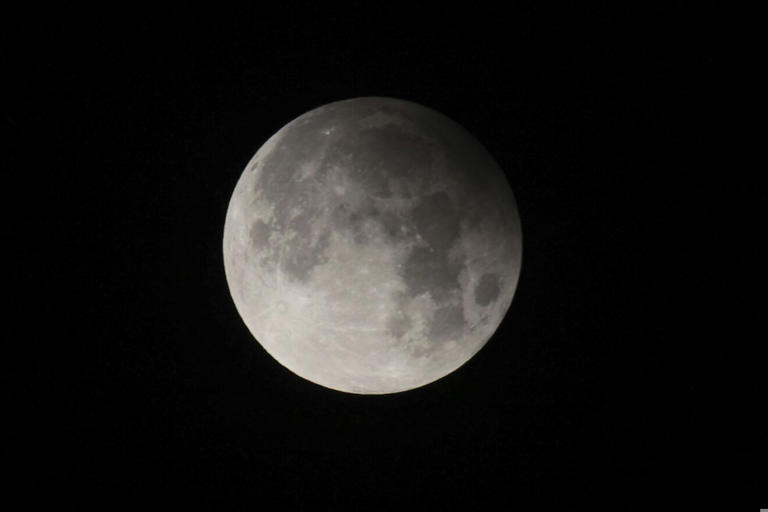

COMMENTS
The animation shows both the orbit and the rotation of the Moon. The yellow circle with the arrow and radial line have been added to make the rotation more apparent. The arrow indicates the direction of rotation. The radial line points to the center of the visible disk of the Moon at 0°N 0°E. Download options
The Moon orbits Earth in the prograde direction and completes one revolution relative to the Vernal Equinox and the stars in about 27.32 days (a tropical month and sidereal month) and one revolution relative to the Sun in about 29.53 days (a synodic month).Earth and the Moon orbit about their barycentre (common centre of mass), which lies about 4,670 km (2,900 mi) from Earth's centre (about 73 ...
Altitude: -32.8° Azimuth: 281.8° Direction: West-North-West The Moon is Earth's only natural satellite and is the fifth-largest satellite in the solar system. It has a diameter of 3,474 kilometers and a mass of 7.34 x 10^22 kilograms, making it about 1/81st the mass of Earth. ... Light takes 1.3314 seconds to travel from The Moon and arrive ...
The Moon follows generally the same path, but with some important differences. The Moon's orbit is tilted 5.1° relative to the ecliptic. So, the Moon can appear anywhere in a band extending 5.1 ...
For instance, a new moon happens when the Moon is between the Earth and the Sun. The whole of the far side of the Moon is in sunshine, but we see (or rather don't see) the side that's in full shadow. During a half moon, we see half of the Moon's day side. The other half is shining out in the opposite direction to Earth.
The moon orbits the Earth once every 27.322 days. It also takes approximately 27 days for the moon to rotate once on its axis. As a result, the moon does not seem to be spinning but appears to ...
The Moon must travel an additional distance of Δb in its orbit before reaching the New Moon phase at b2. This graphically demonstrates why the synodic month is longer (~1.98 days) than the anomalistic month. ... in the same direction as the Moon's orbital motion. This corresponds to an average of 40.7° per year, so it takes 8.85 years (3231.6 ...
The Moon is always half-lit by the sun (except during a lunar eclipse ). The side of the Moon facing the Sun appears bright because of reflected sunlight, and the side of the Moon facing away from the Sun is dark. Our perspective on the half-lit Moon changes as the Moon orbits Earth. When the side nearest to us is fully lit, we call this a full ...
An enduring myth about the Moon is that it doesn't rotate. While it's true that the Moon keeps the same face to us, this only happens because the Moon rotates at the same rate as its orbital motion, a special case of tidal locking called synchronous rotation.The animation shows both the orbit and the rotation of the Moon.
From your astronaut's viewpoint, you can see that the Moon is an average of 238,855 miles (384,399 km) from Earth, or about the space that could be occupied by 30 Earths. It travels around our planet once every 27.322 days in an elliptical orbit, an elongated circle. The Moon is tidally locked with Earth, which means that it spins on its axis ...
The Moon was likely formed after a Mars-sized body collided with Earth several billion years ago. Earth's only natural satellite is simply called "the Moon" because people didn't know other moons existed until Galileo Galilei discovered four moons orbiting Jupiter in 1610. In Latin, the Moon was called Luna, which is the main adjective for […]
A visualization of how the Moon orbits Earth, explaining why we always see the same side facing us.
The answer is yes, the moon rotates, but it does so much more slowly than Earth does. A "moon day" is around 29.53 Earth days, according to NASA. In other words, whereas Earth completes one ...
Ben Cooper. Because Earth rotates on its axis from west to east, the Moon and the Sun (and all other celestial objects) appear to move from east to west across the sky. Viewed from above, however ...
There's a good reason why all these orbits are so circular: it has to do with how the solar system was formed in the first place. Answer 3: The moon travels an almost circular orbit around the earth at a mean distance of 384,400 kilometers. The moon rotates around the earth in the same direction that the earth rotates around the sun.
The eight Moon phases: 🌑 New: We cannot see the Moon when it is a new moon. 🌒 Waxing Crescent: In the Northern Hemisphere, we see the waxing crescent phase as a thin crescent of light on the right. 🌓 First Quarter: We see the first quarter phase as a half moon. 🌔 Waxing Gibbous: The waxing gibbous phase is between a half moon and ...
MoonCalc shows the motion of the Moon and Moon phase for a particular day at a particular location.. You can see the moon positions for moon rising, selected time and Moonset.The thin yellow-colored curve shows the trajectory of the moon. The closer the moon in the middle, the higher the moon above the horizon.
The Moon phases visualization shows the positions of the Moon and Earth in real time. Distances are not to scale. The Sun is not shown, however, the Earth's illumination indicates its position to the left. Because of the Earth's axial tilt, the Sun's assumed location shifts up and down slightly over the course of the year in this animation ...
The Moon orbits Earth at a speed of 2,288 miles per hour (3,683 kilometers per hour). During this time it travels a distance of 1,423,000 miles (2,290,000 kilometers). How fast does the Moon travel around Earth? | Cool Cosmos.
As the moon passes across the face of the sun, it casts its shadow in the same direction in which it is moving, from west to east. "It's a rising and a setting concept," says Jackie Faherty ...
The answer is one—the moon ... sometimes closer to the sun and traveling ahead and sometimes farther out and moving in the reverse direction. In other words, it looks like the asteroid is going ...
The Moon's orbital speed is greatest when it is at its closest approach to the Earth. The moon travels around the earth in a counterclockwise direction. The moon moves from west to east. It moves ...
How and why the full 'Worm Moon' aligns for March 25's lunar eclipse and April 8's total solar eclipse. On Monday, March 25, the full "Worm Moon" will cause a penumbral lunar eclipse for the night ...
The moon's shadow makes landfall in Mexico at 2:07 p.m. Eastern time, casting the first region into darkness. Here, darkness lasts for about four minutes near the center of the path, but ...
The arrow indicates the direction of rotation. The radial line points to the center of the visible disk of the Moon at 0°N 0°E. Download options. Return to top. The National Aeronautics and Space Administration. NASA explores the unknown in air and space, innovates for the benefit of humanity, and inspires the world through discovery. ...
The moon was scheduled to enter the shadow at 12:53 a.m. ET, according to NASA, reaching its greatest eclipse at 3:13 a.m. when 96% of the moon was in partial shadow, and exiting the shadow at 5: ...
New Moon. This is the invisible phase of the Moon, with the illuminated side of the Moon facing the Sun and the night side facing Earth. In this phase, the Moon is in the same part of the sky as the Sun and rises and sets with the Sun. Not only is the illuminated side facing away from the Earth, it's also up during the day!
On April 8, the moon will slip between the Earth and the sun, casting a shadow across a swath of North America: a total solar eclipse. By cosmic coincidence, the moon and the sun appear roughly ...
The March Full Moon arrives with the first of four eclipses of 2024. Called a penumbral lunar eclipse, it occurs when the Moon enters the Earth's partial shadow, known as a penumbra, a phenomenon ...
A glowing worm moon will light up the sky on Monday with a celestial performance in store for people venturing out in the early morning hours — a penumbral lunar eclipse.. March's full moon ...